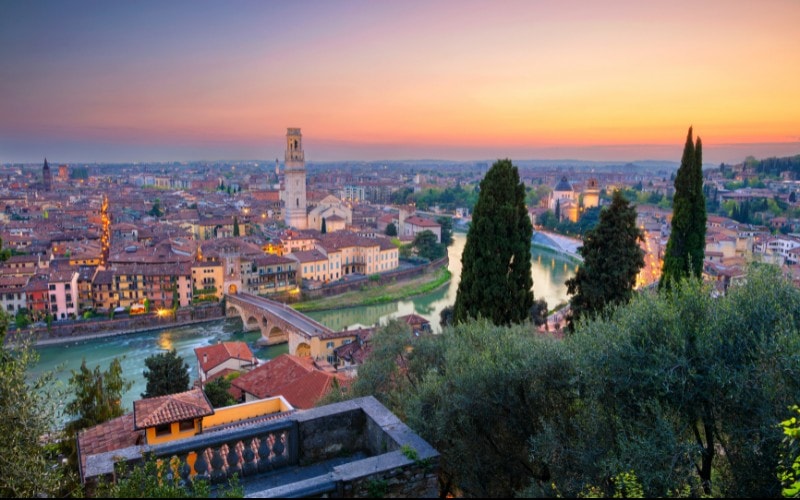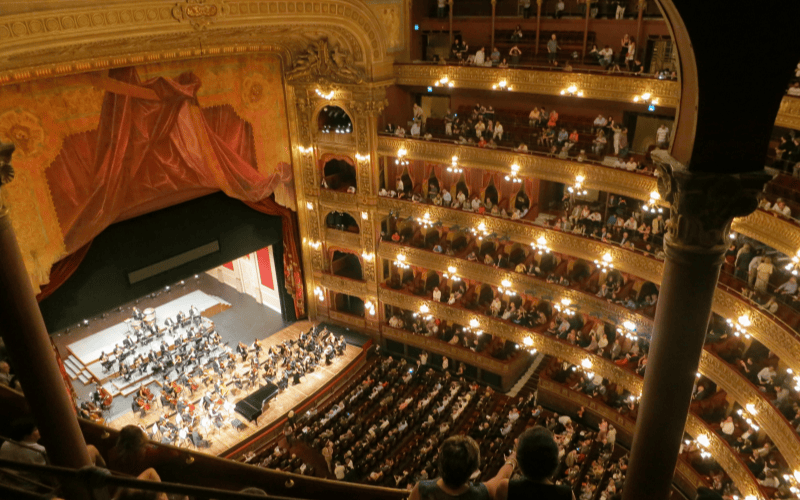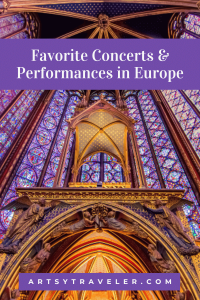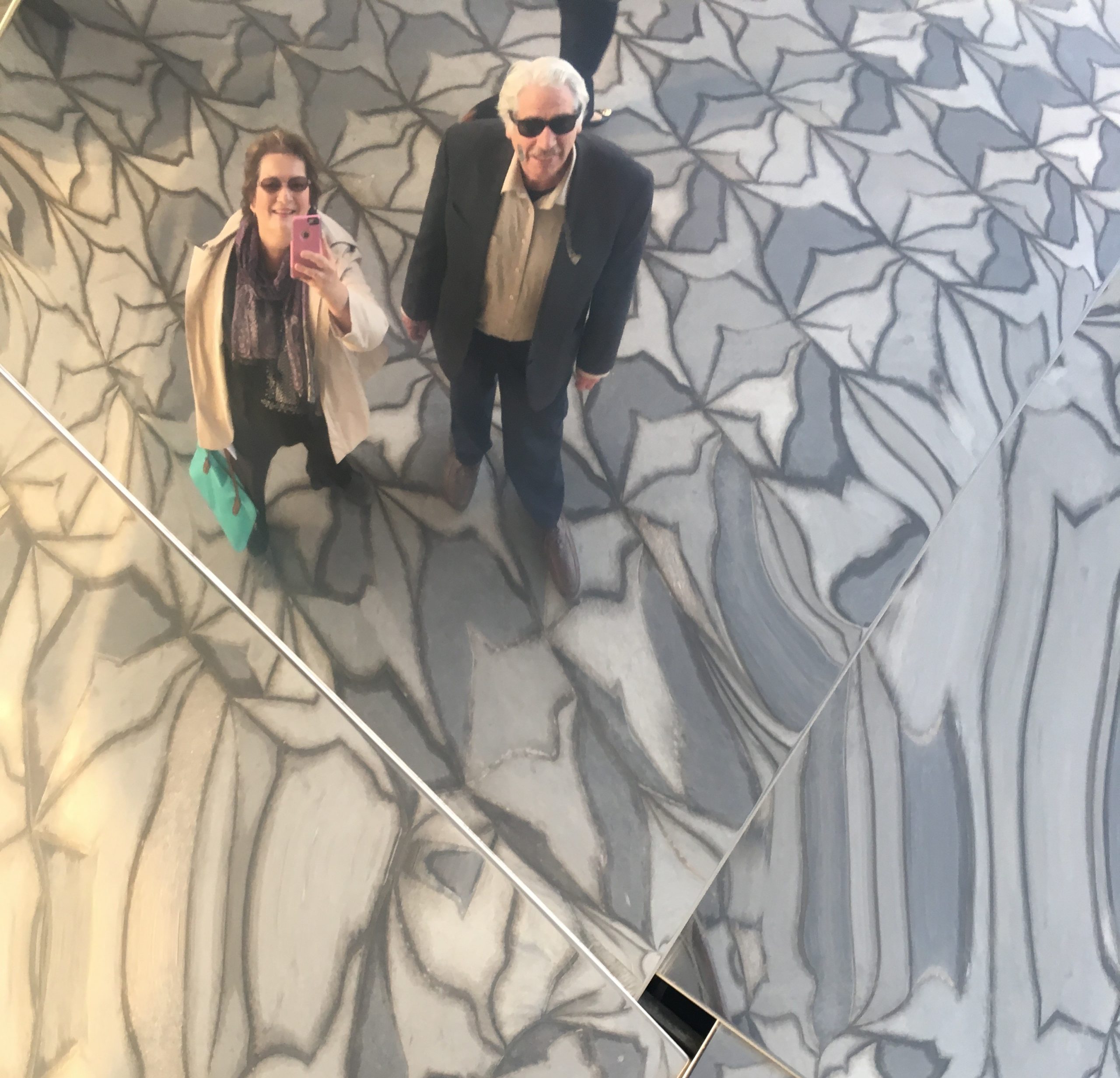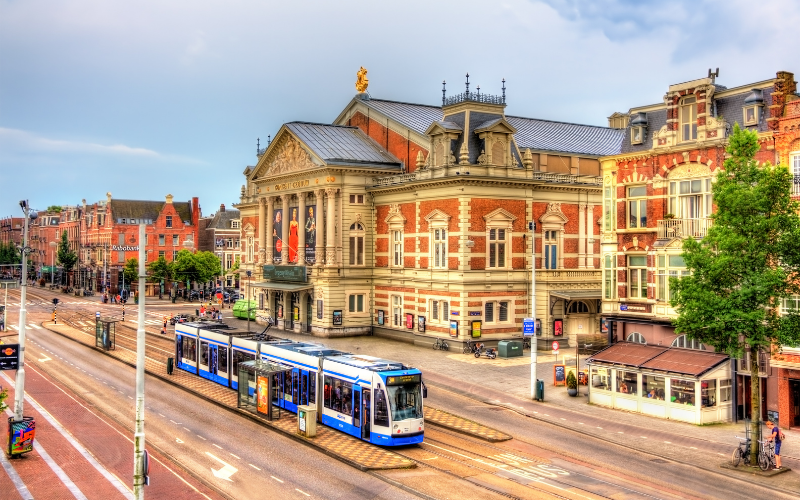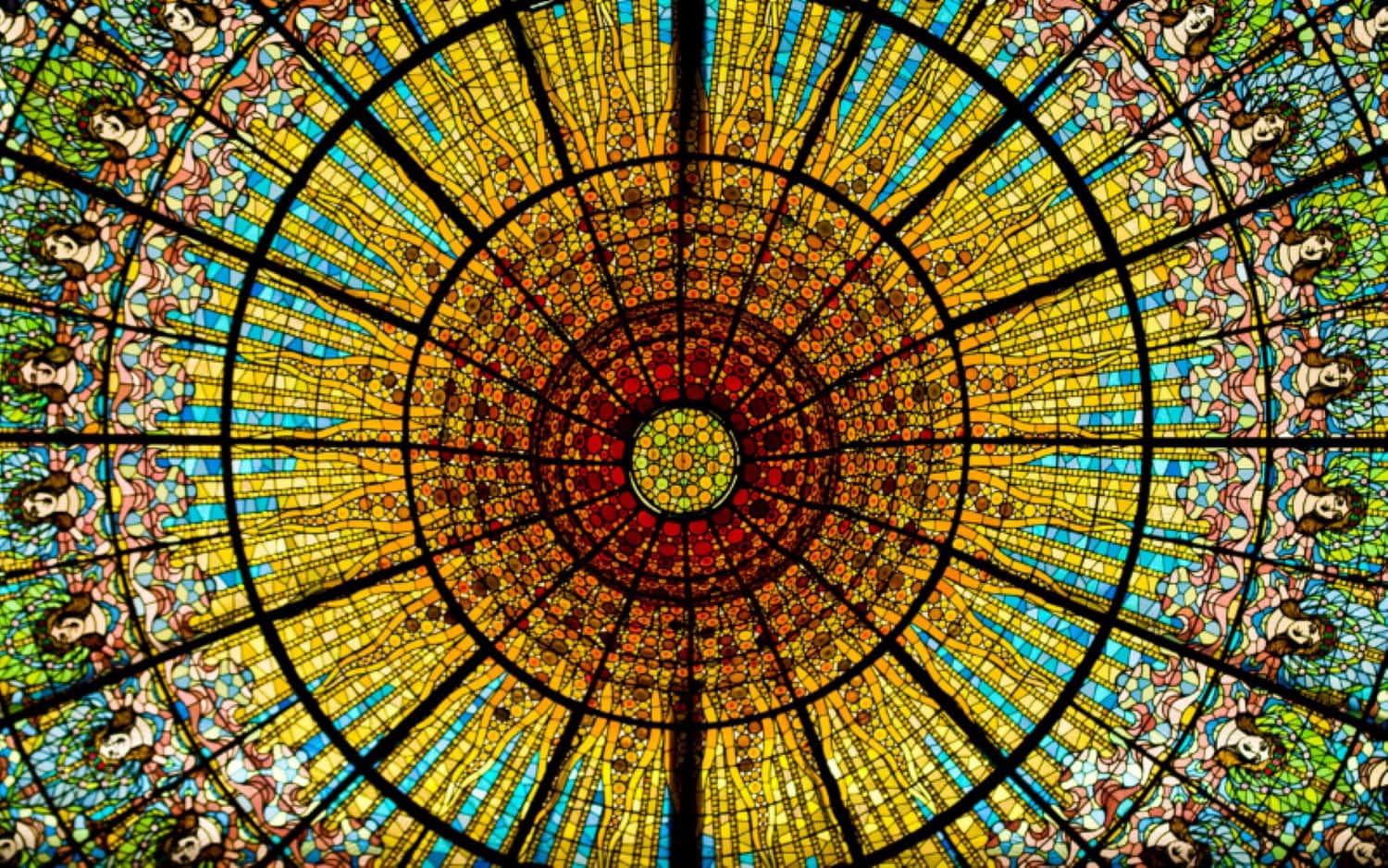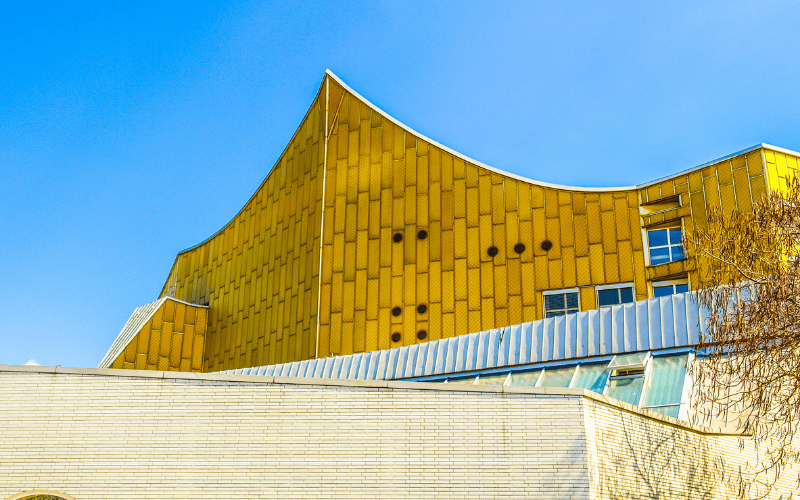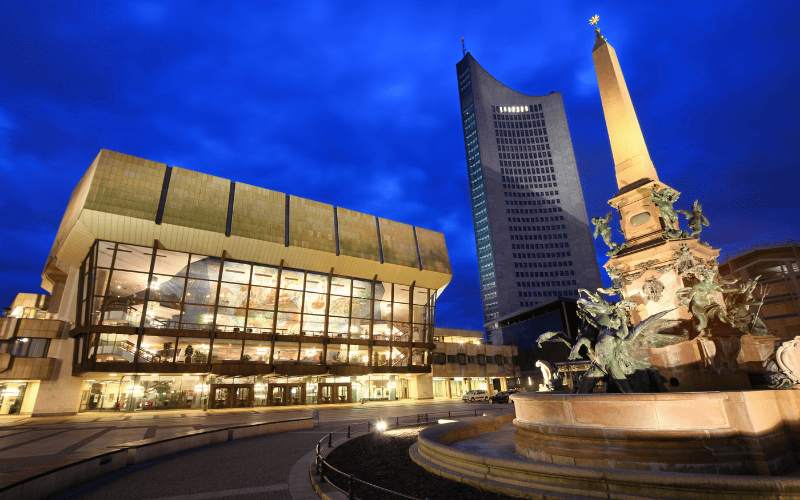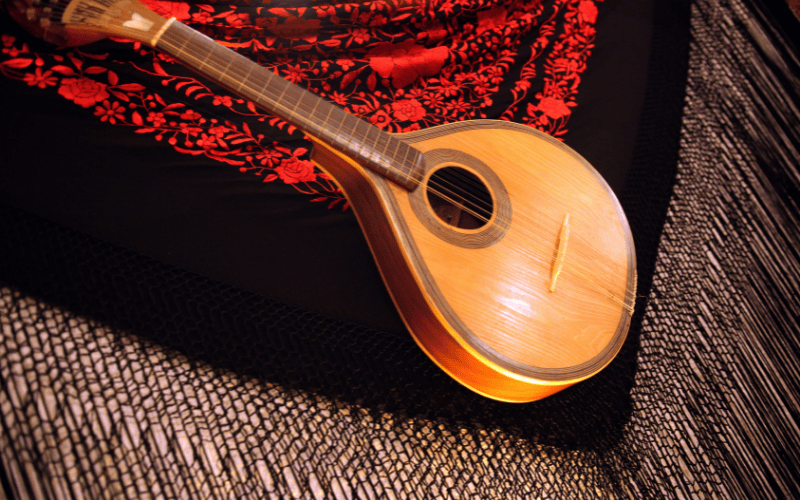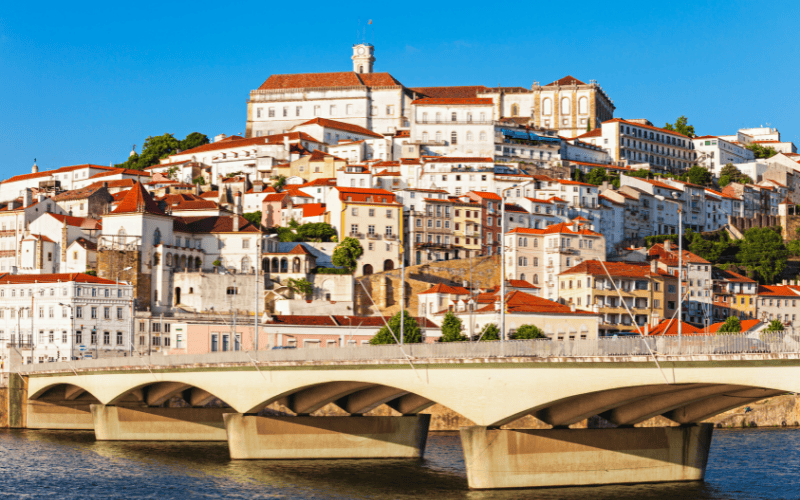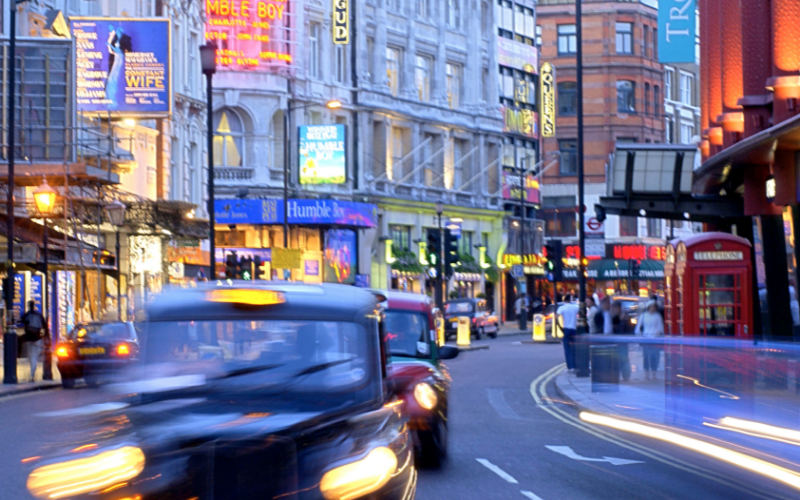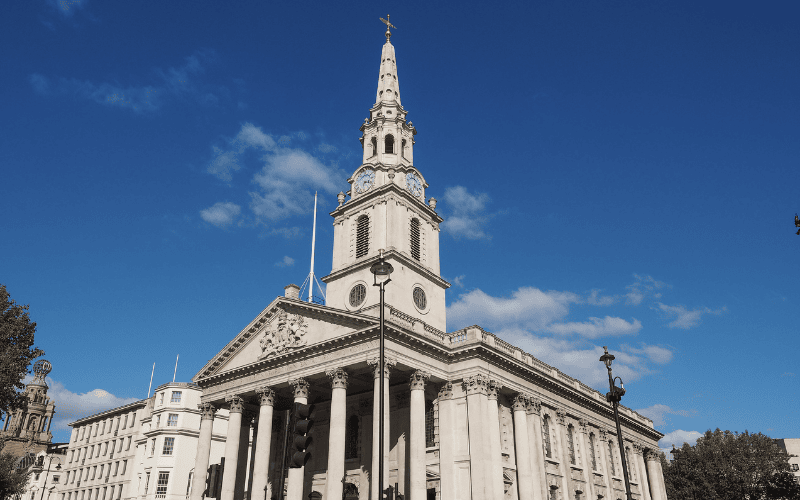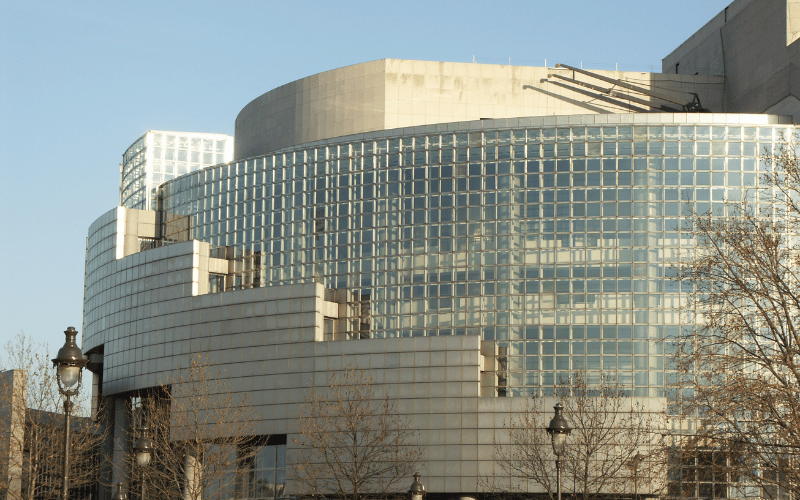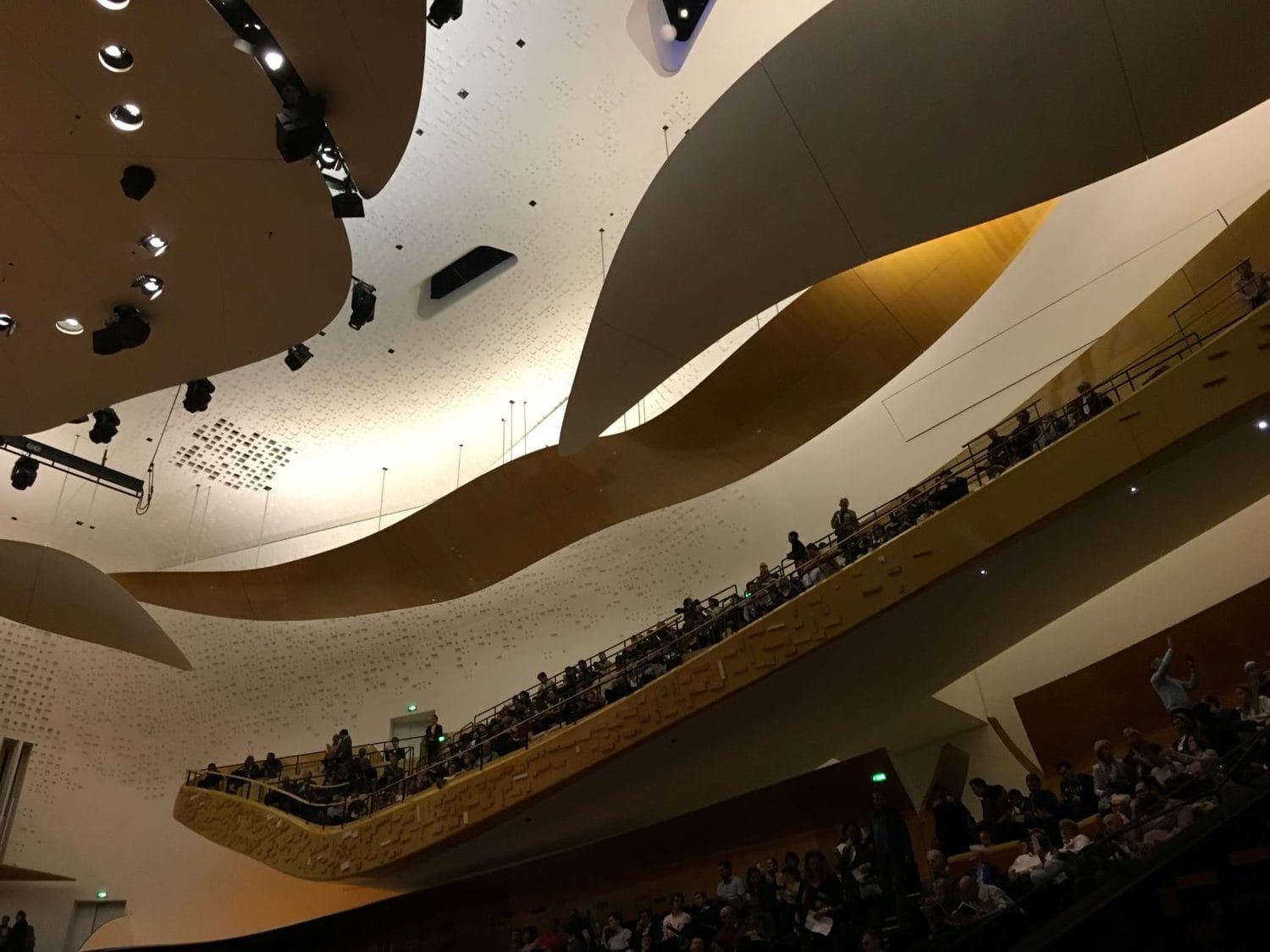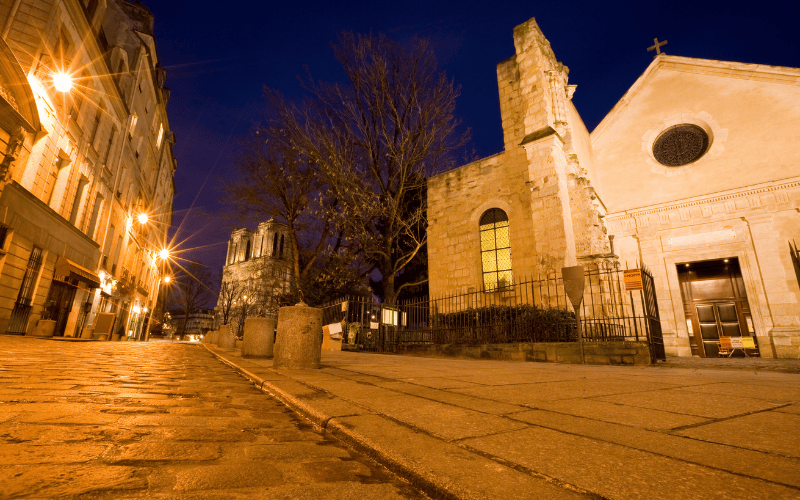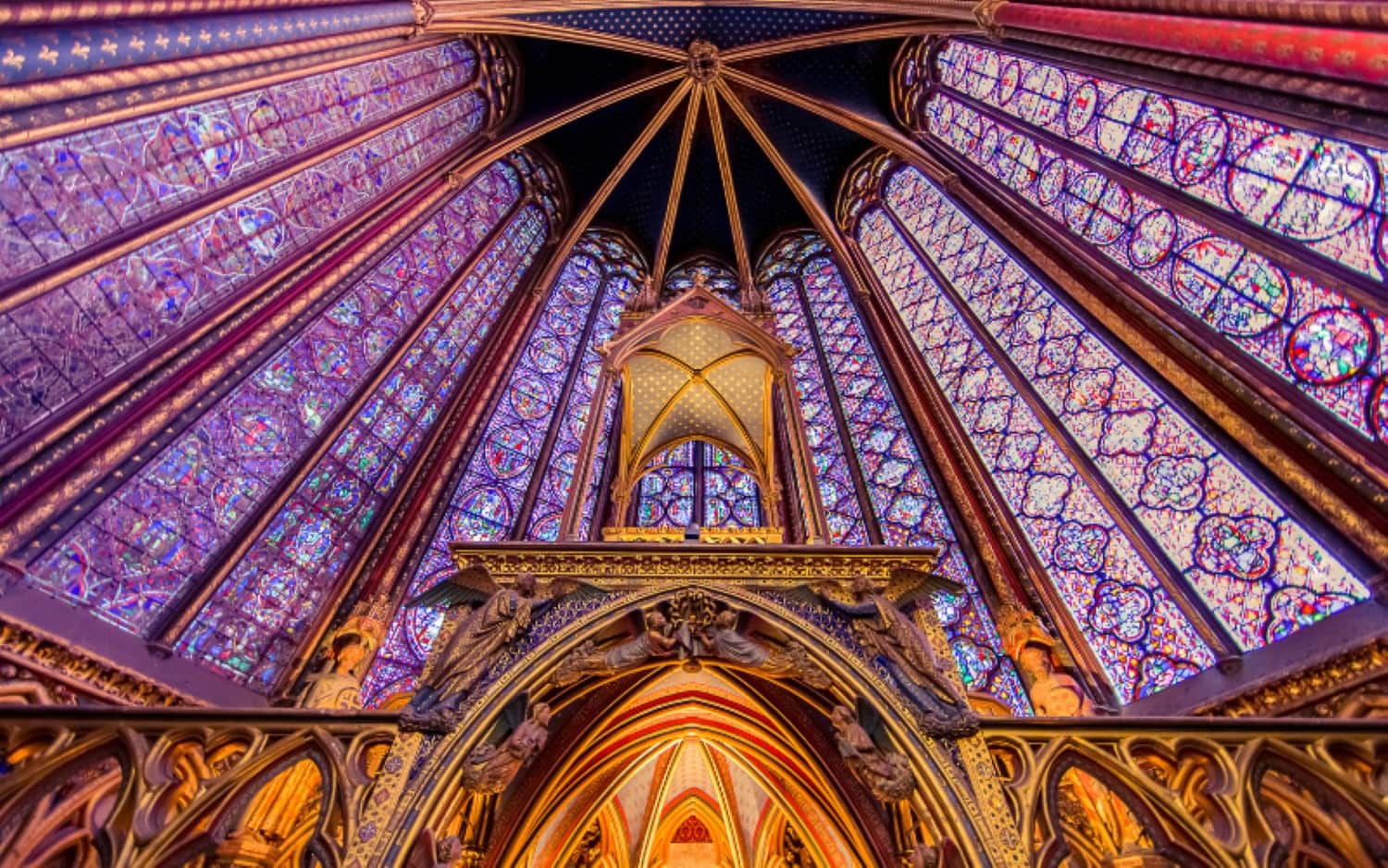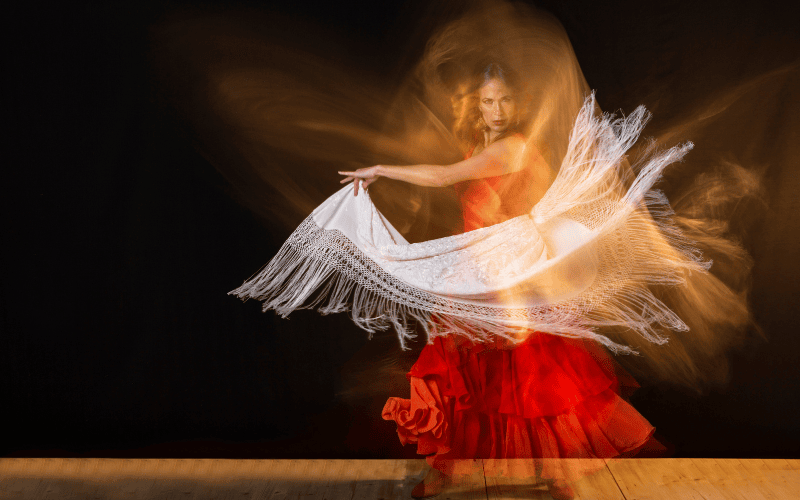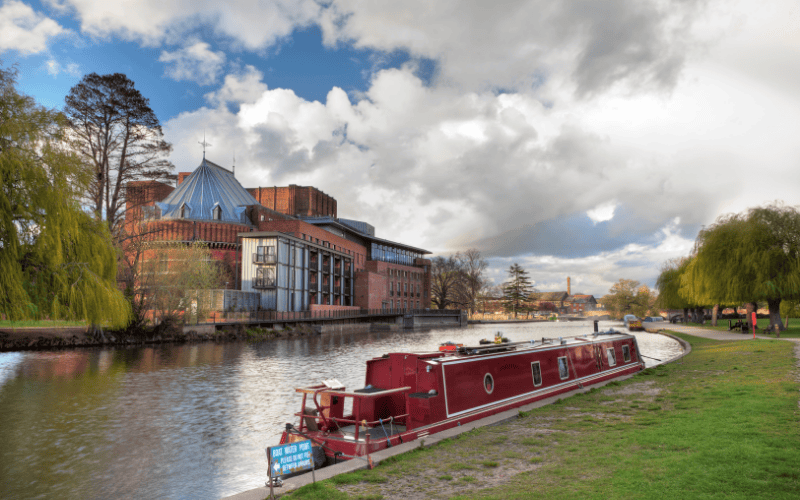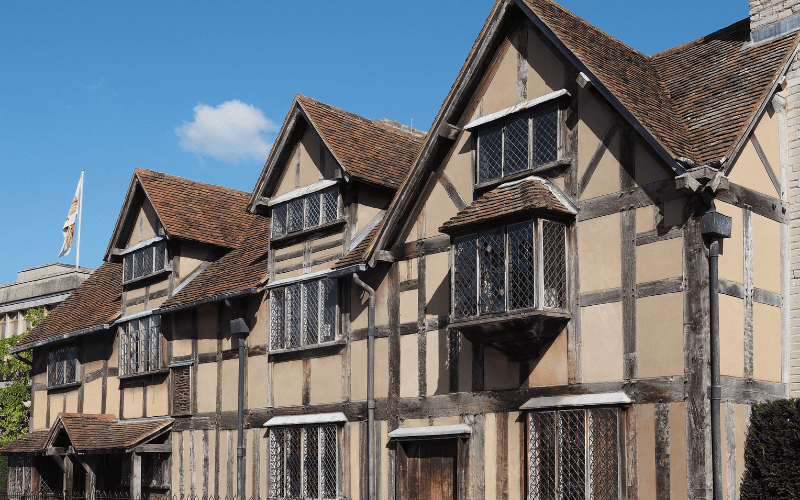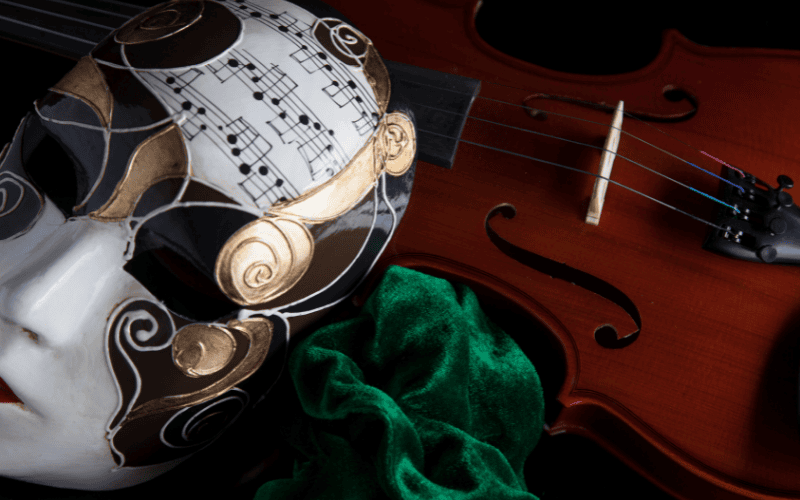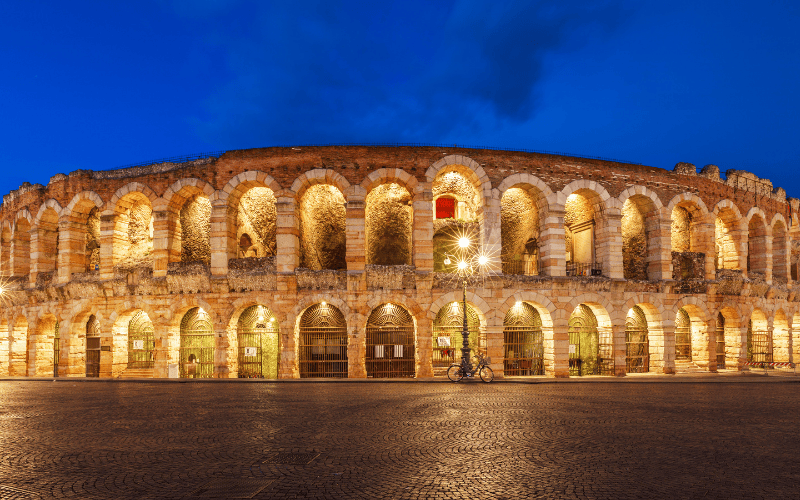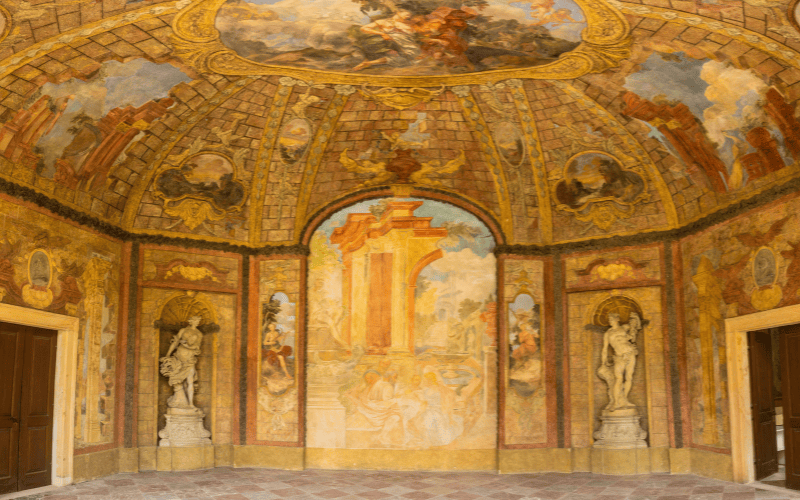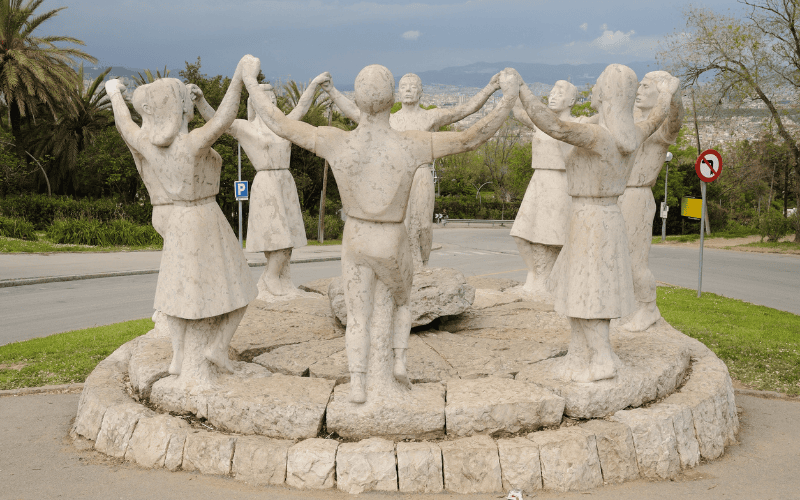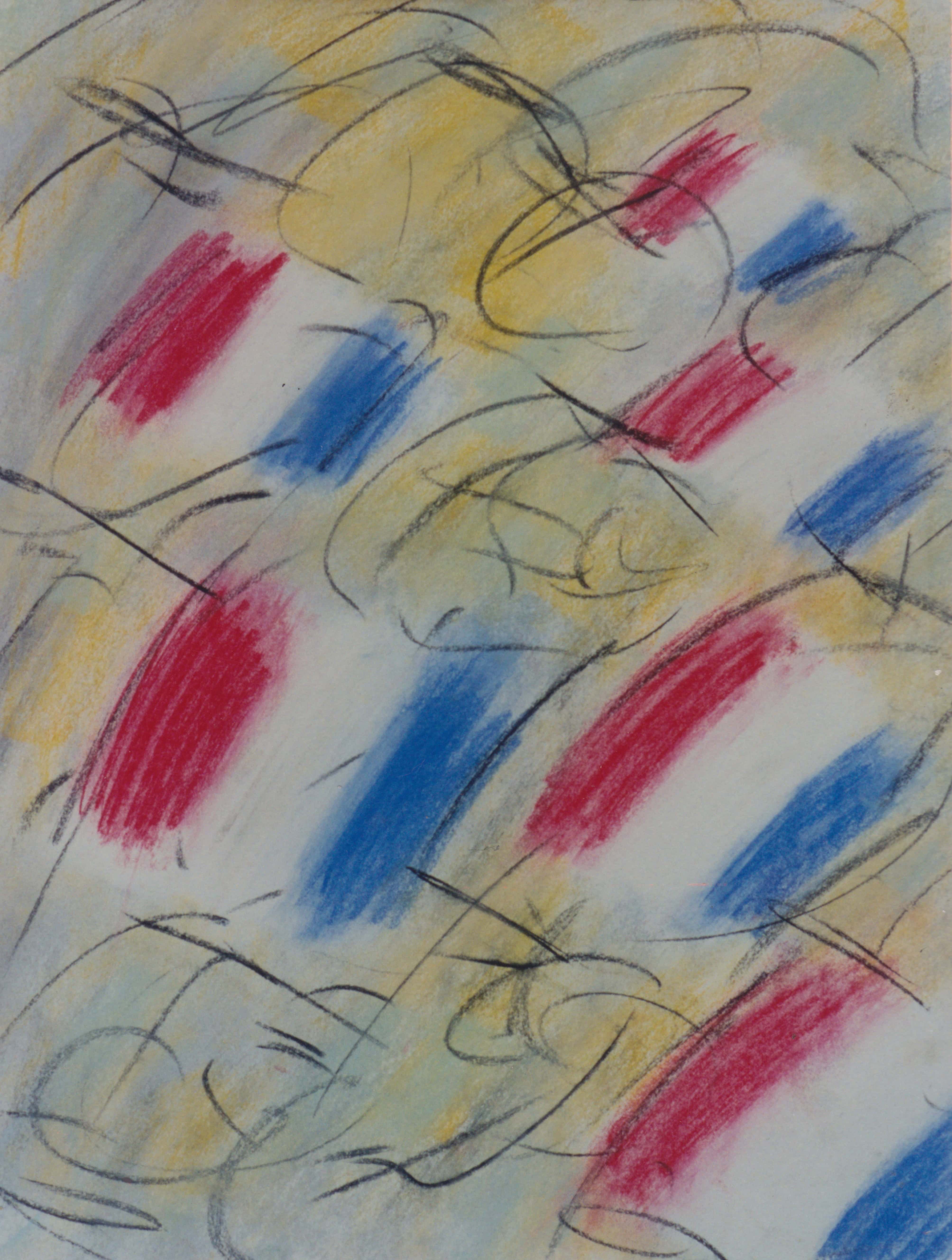Beyond Romeo and Juliet: What to See in Verona, Italy
Heading to northern Italy? Consider spending time in lovely Verona, which has plenty to see beyond its connection to Romeo and Juliet
The city’s central location makes it an excellent home base for touring the region, and you’ll find lots of opportunities for artsy sightseeing.
Guest poster Zoe Disigny, author of The Art of Traveling Strangers, shares her experience exploring Verona’s many artsy attractions during a week’s stay.
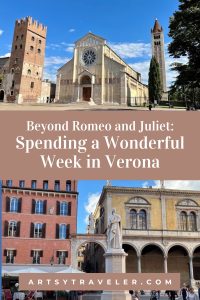
Introduction
When most people think of “fair” Verona, they typically think of Shakespeare’s play Romeo and Juliet.
Two households, both alike in dignity
(In fair Verona, where we lay our scene),
From ancient grudge break to new mutiny,
Where civil blood makes civil hands unclean. (Prologue.1–4)
But when I recently stayed in Verona for a week on a house exchange, it wasn’t the romantic story of Romeo and Juliet that I had in mind.
It was the city’s real history. For me, that’s the true romance of Verona.
History of Verona
Thanks to its location along the Adige River in the Veneto region of northern Italy, Verona has been inhabited since prehistoric times. It became a Roman town in the third century B.C. and was one of the most important Italian cities during the Roman era.
Because of its strategic location on the river, it was used as a base for overseeing the northern territories and was at the intersection of many important roads.
Today, everywhere you look, the city teems with Roman art and architecture.
But that’s not all. Medieval Verona is equally represented, with its many artifacts woven seamlessly throughout the city. Add the city’s Renaissance and Baroque masterpieces, and this art-historical wonderland is complete.
No wonder Verona is a UNESCO World Heritage site.
Arrival in Verona
My first experience with the city of Verona was at night. We arrived after taking the train directly from Venice, an hour away. We then took an Uber to our house exchange on the left bank of the Adige River.
After settling in, we went in search of a restaurant.
We walked across the Ponte Vittoria (Victory Bridge) and, in five minutes, found ourselves right in the middle of Piazza Brà, otherwise known as tourist central.
The piazza was packed, and the energy electric. We quickly found an outdoor table across from Verona’s famous Roman arena and ordered—what else—pizza!
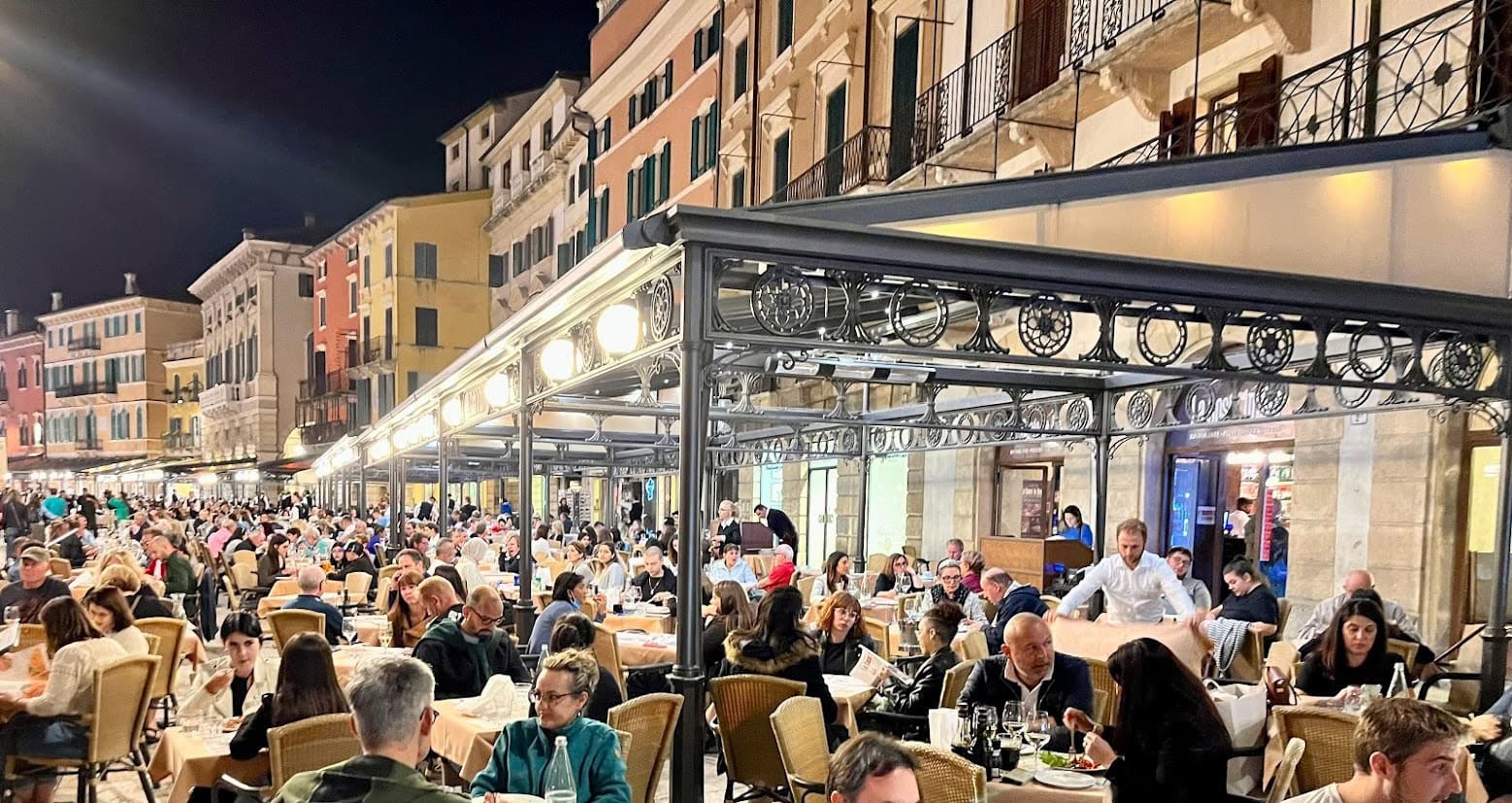
What to See in Verona
Following is an overview of the places I visited during my week in Verona. While you can see quite a lot of the city in a day, slow down and consider spending a full week, or at least two or three full days. Verona has a lot to offer!
The Verona Arena
The most prominent reminder of Verona’s Roman past is the Arena di Verona. This must-see attraction was built in 30 AD (forty years before the Colosseum in Rome). The ancient Romans staged deadly gladiator and animal fights here—an entertainment staple throughout the Roman world.
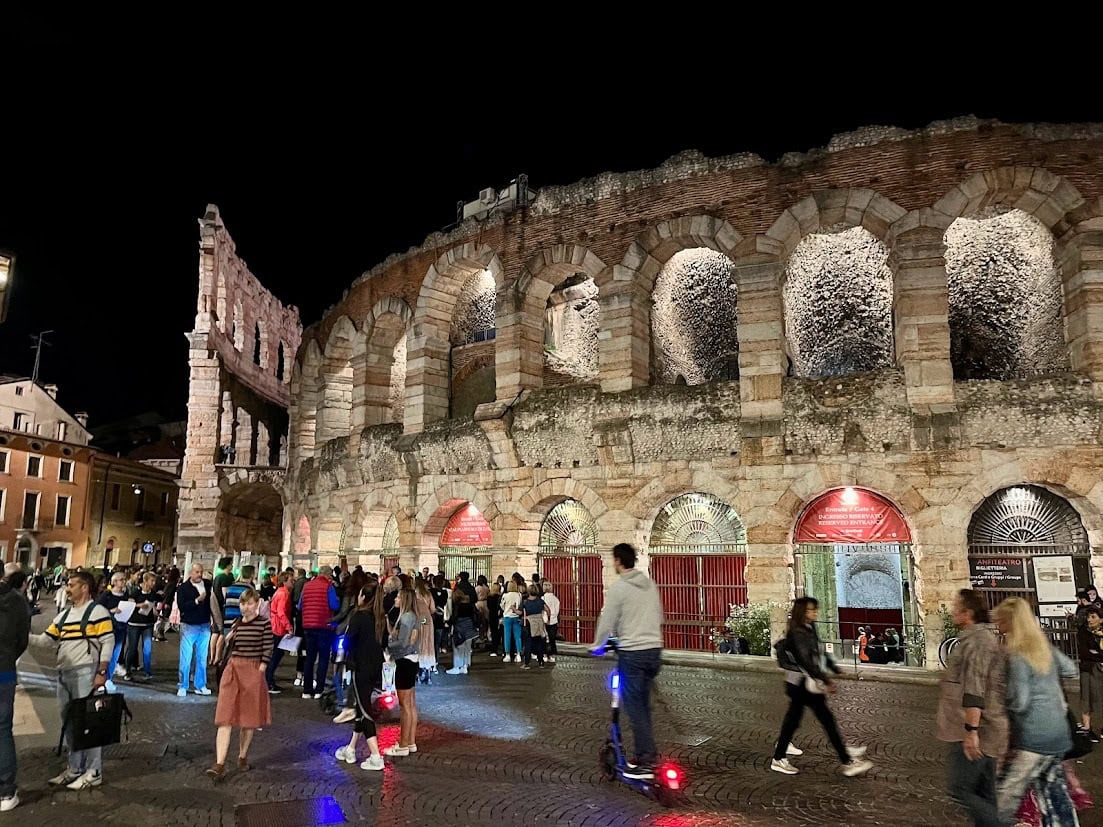
In the following centuries, as was the medieval custom, the arena became a rich source for the construction materials needed to create new buildings in the city.
The structure we see today is the result of this constant scavenging and a devastating twelfth-century earthquake.
The arena has been in continual use over the centuries.
In the Middle Ages, judicial disputes were resolved by hand-to-hand combat here, and until the 18th century, this was the site of jousts and tournaments.
Today, the arena is the setting for Verona’s world-famous opera season.
Piazza Brà
The Piazza Brà is the main square in the center of Verona. (The term bra is derived from the German word breit, which means broad.) It’s one of Italy’s largest piazzas and an ideal spot for people-watching.
The welcoming, open space is paved with pink marble and lined with restaurants, majestic historical buildings, and the picturesque Portoni della Brà (Gates of the Bra).
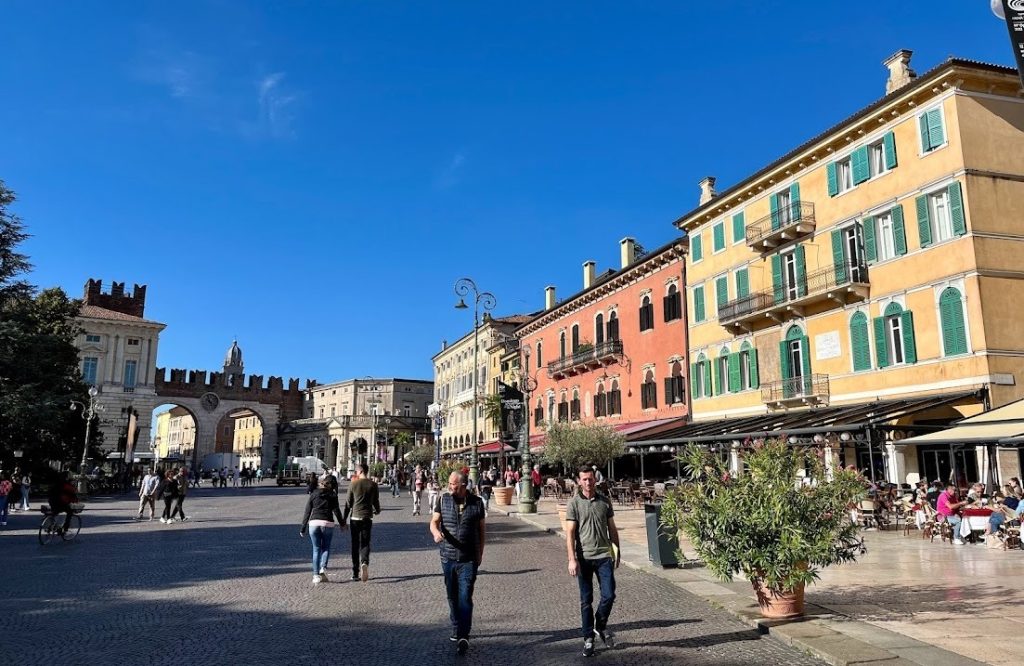
The Portoni della Piazza Brà archways are embedded in Verona’s medieval walls, connecting the city to the suburban countryside at the time.
Verona Tourist Office
The tourist office is located in the Piazza Brà. Here you can buy tickets for the Hop-on-Hop-off bus to explore Verona or book other city tours.
When I was younger, I had nothing but disdain for tourists who chose to explore a city in such a superficial manner.
Now, I’ve realized it’s an excellent way to quickly get the big picture, find your favorite points of interest, and save your feet for the main events—museums, churches, castles, and ruins.
Here are some tours in Verona to consider:
Porta Borsari
Not far from the Piazza Brà stands the impressive Porta Borsari (the Borsari Gate). Built in the first century AD, it was the primary entrance to the city in Roman times.
And it was here that medieval tax collectors charged tariffs on goods entering and exiting the city; hence the gate’s name, which roughly translates to “the money purse gate.”
On the other side of the gate is the Corso Porta Borsari, an ancient Roman street. Now, it’s a charming pedestrian shopping district known for its shoe stores.
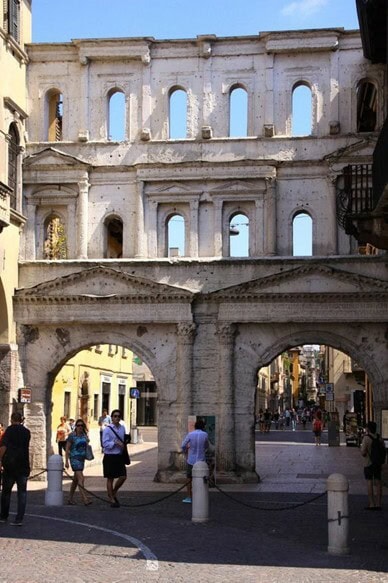
Via Mazzini
Another ancient street—Via Mazzini—is slightly beyond the Porta Dei Borsari. The buildings on either side of this marbled walkway house Verona’s most elegant shops.
Although these stores sell the latest fashions, they’re rooted—as is everywhere else in Verona—in the past (literally).
A good example of this is the Benetton store. Its ground floor is covered in glass so you can see the first-century Roman domus (home) excavated beneath it.
Piazza delle Erbe
Both Via Mazzini and Corso Porta Borsari lead to the rectangular Piazza delle Erbe (Plaza of Herbs), originally the site of the Roman Forum.
This bustling square, surrounded by historic buildings, is now home to an open-air market, continuing one of the ancient forum’s traditional functions.
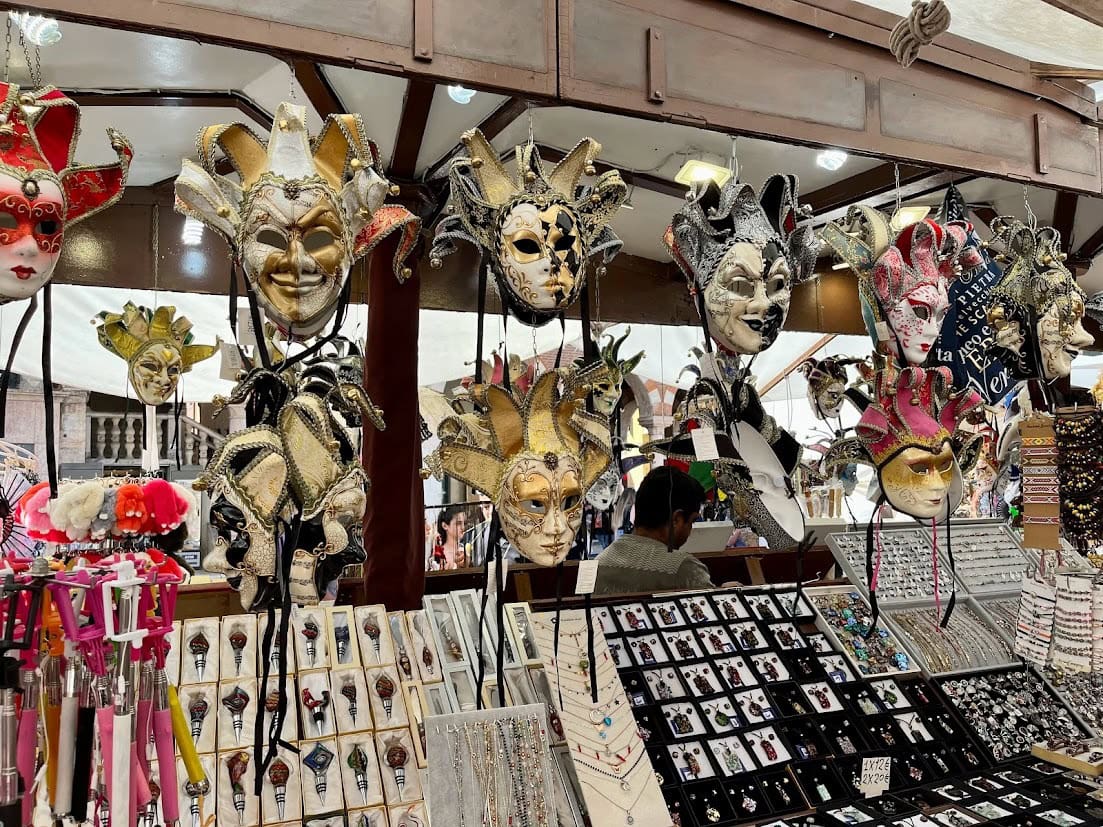
Three historic relics adorn the middle length of the piazza: the Capitello, Madonna di Verona, and The Winged Lion of St. Mark.
Capitello
The Capitello (Capital) is a thirteenth-century canopied podium used in the Middle Ages to swear in magistrates.
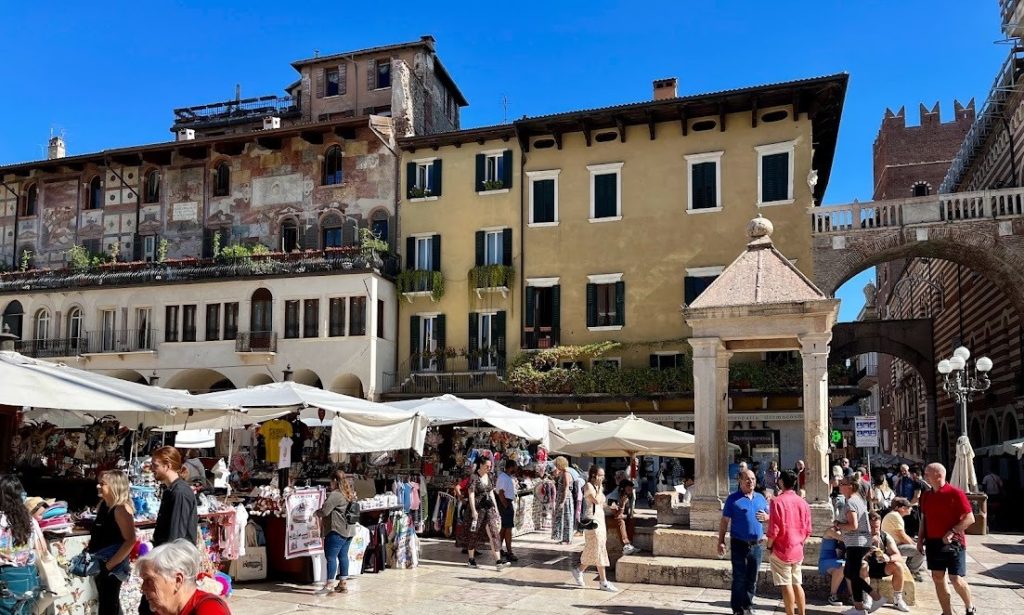
Madonna di Verona
The Madonna di Verona (My Lady of Verona) fountain is named for the Roman sculpture it supports. In 1368, the original statue that had inhabited the piazza since the first century was restored, given a crown, and placed atop a fountain.
This was at the peak of Verona’s medieval political power, and the sculpture was intended to personify the great city.
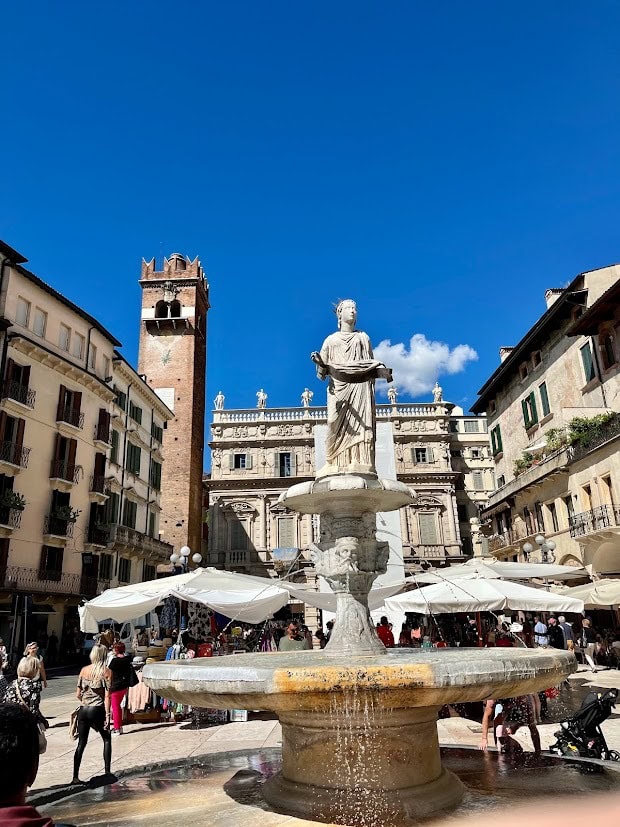
Winged Lion of St. Mark
A tall marble column supports the winged lion of St. Mark. The sculpture was erected in 1523 as an emblem of the Venice Republic, which ruled Verona from the fifteenth to the eighteenth centuries.
Casa Mazzanti
Another art historical find in the Piazza delle Erbe is the painted façade of the Case Mazzanti (Mazzanti Houses), originally the residence of the powerful della Scala family, who ruled Verona during its medieval heydays.
In sixteenth and seventeenth century Verona, the palace facades of the city’s most prominent families were often entirely decorated with frescoes, so much so that Verona was nicknamed the painted city.
Many of these paintings did not survive, were plastered over, or were detached from their walls and exhibited in museums.
One of the best-preserved examples, and still in its original location, is Case Mazzanti, painted by Alberto Cavalli, a collaborator of the Mannerist painter Giulio Romano. It’s easy to see the influence of Michelangelo’s muscular style in these monumental frescoes.
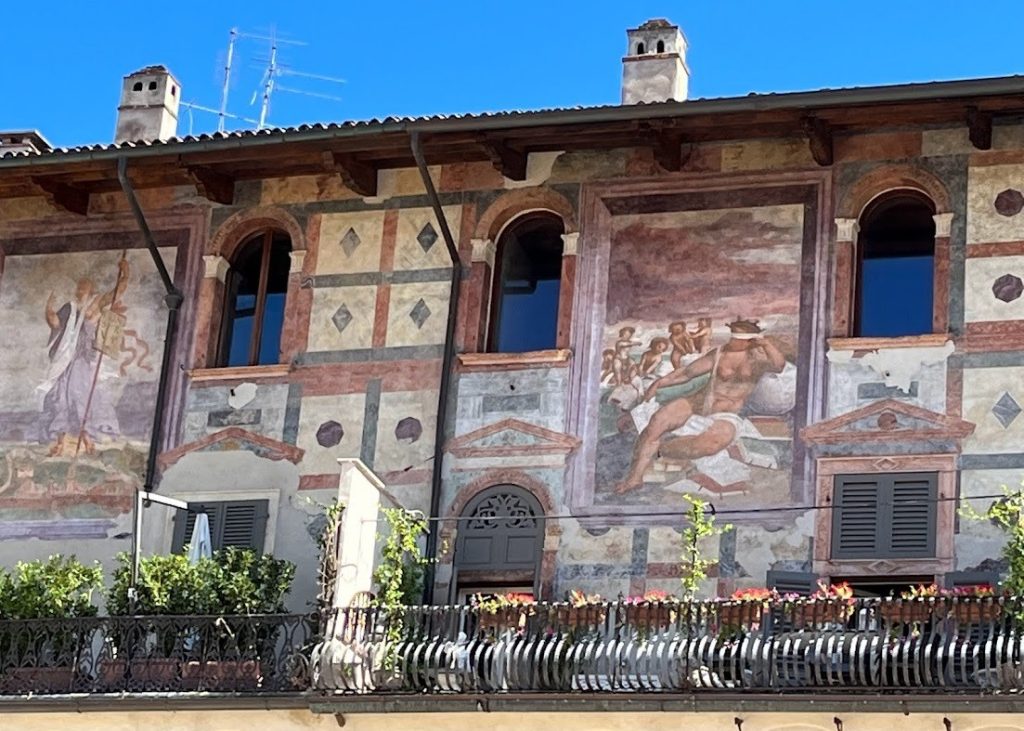
Palazzo Maffei
At the northwest end of the piazza, the Palazzo Maffei (Maffei Palace) provides a grand theatrical finale to the entire space. The original building dates back to the fourteenth century but was completely redesigned into a sumptuous Baroque mansion in the seventeenth century.
Today, the palazzo houses the Casa Museo (House Museum) art collection and a fabulous restaurant—the Ristorante Maffei. The museum was closed when we were there, but we were able to eat a delicious lunch between the grand Baroque columns of its elegant courtyard.
Verona’s Roman Theater and Archaeological Museum
From the Palazzo Maffei, we wandered the narrow streets to the picturesque Ponte Pietra (Stone Bridge)—first built in Roman times but rebuilt often since. Crossing the bridge, we came to Verona’s restored Roman theater, dating to the first century AD and still used today.
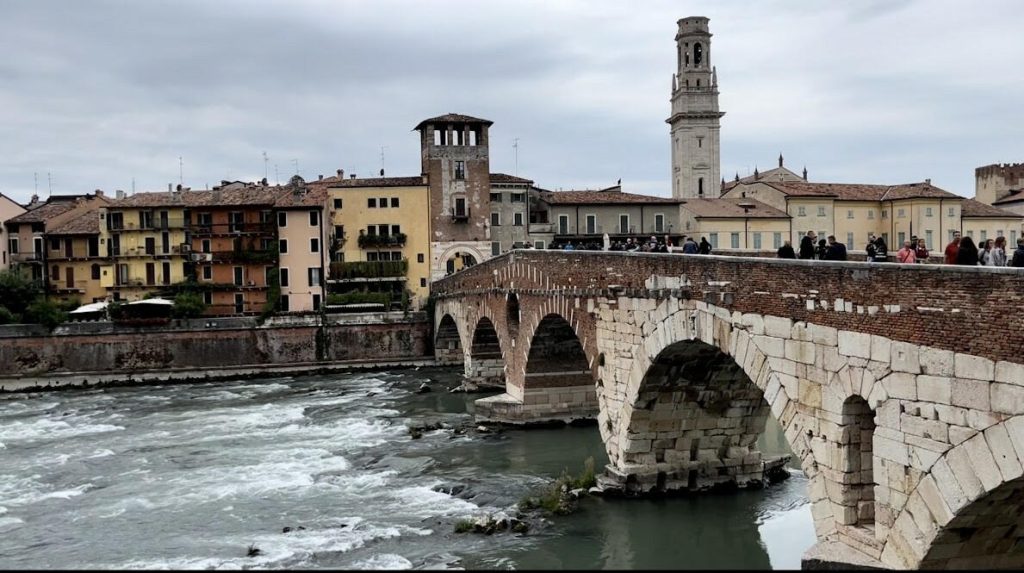
An impressive archaeological museum nestles in the hillside high above the theater in what used to be a fifteenth-century Jesuit monastery.
It’s a steep climb on uneven steps to get to the museum, but it’s worth it for those who like ancient art and a stunning historic setting.


Archaeological Museum
Here are two interesting exhibits in the Archaeological Museum–an ancient Greek rhyton (drinking cup) from the 4th century BC and the torso of a Roman soldier.
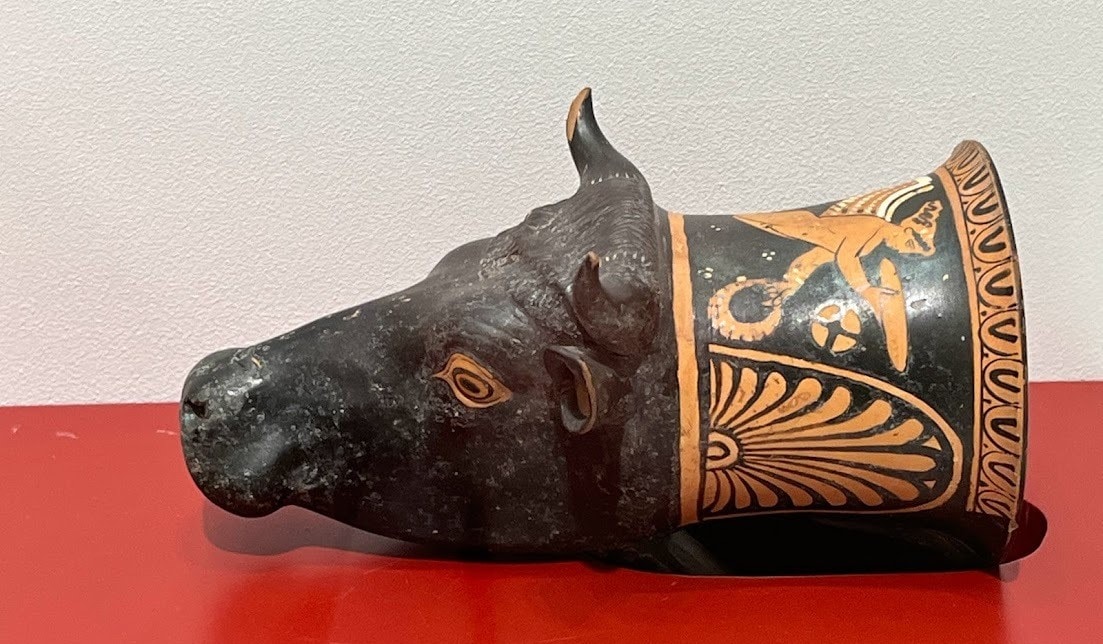
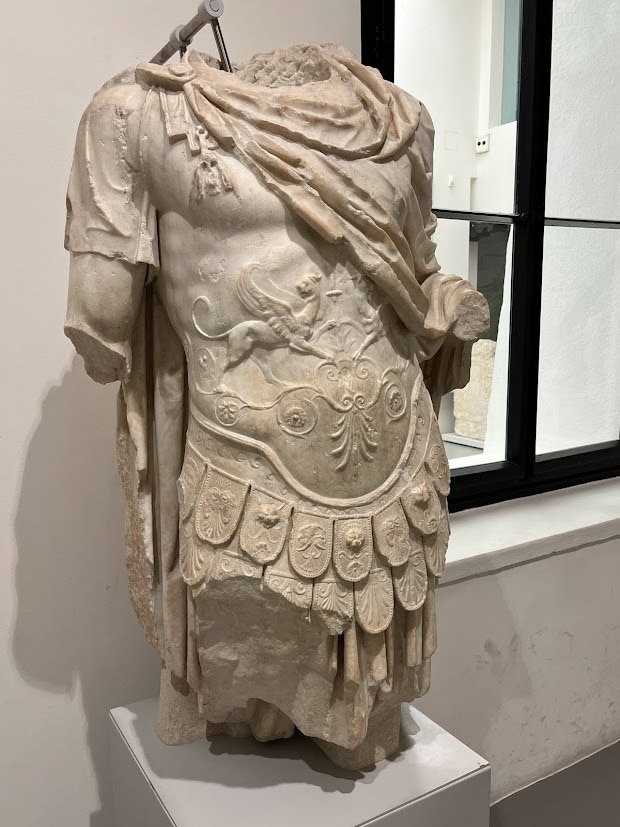
Verona’s Piazza dei Signori
Returning across the Ponte Pietra, we came upon the Piazza dei Signori (Plaza of the Lords) with its statue of Dante in the center.
The sculpture was commissioned in 1863 to honor the six-hundredth anniversary of Dante’s birth. Dante lived in Verona for seven years after his exile from Florence. Verona’s oldest café is also in this piazza. It named itself Caffè Dante after the Dante monument was installed. We didn’t eat at Caffè Dante, but I wish we had!
Shown below is the Piazza dei Signori. The Caffè Dante is to the left; the sculpture of Dante is in the center, and the Loggia del Consiglio is to the right.
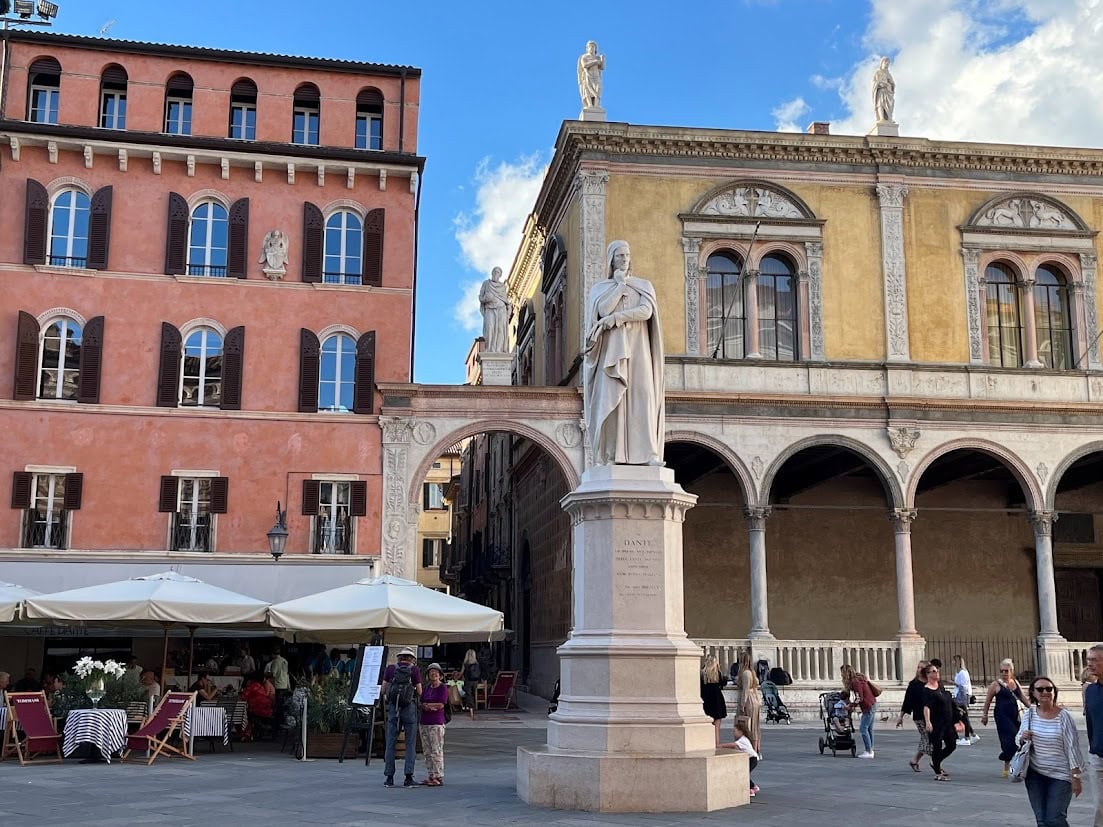
Palazzo della Ragione and Loggia del Consiglio
The piazza is surrounded by splendid buildings that began in the Middle Ages. The Palazzo della Ragione (Town Hall) was built by the powerful della Scala family mentioned earlier.
They ruled Verona during the thirteenth and fourteenth centuries—a time of significant economic and cultural achievement for the city. The palace had four towers in medieval times, but only one remains today—the breathtaking 275-foot-high Torre dei Lamberti (Lamberti Tower).
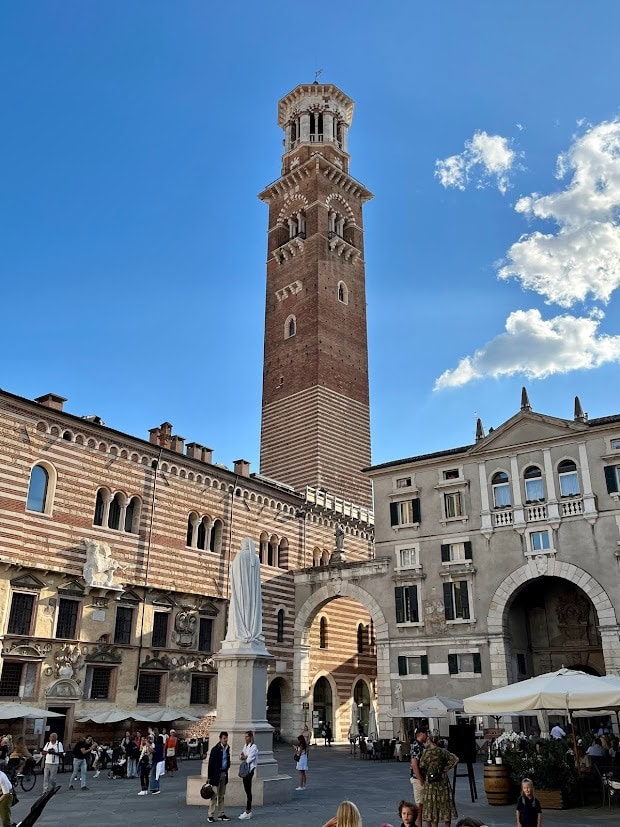
On the north side of the Piazza dei Signori stands the fifteenth-century Loggia del Consiglio (Loggia of the Council)—a classic example of Early Renaissance design. The figures on top represent famous Verona citizens.
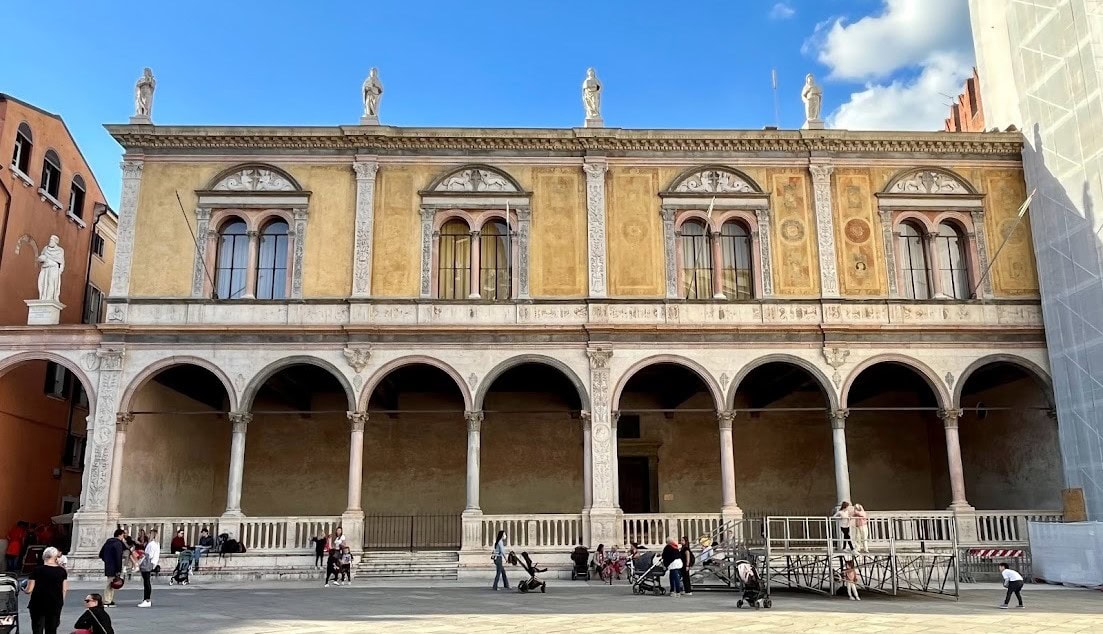
The two buildings offer a sharp contrast of styles. While the medieval town hall incorporated soaring towers into its overall design to sweep you off your feet, the Renaissance loggia appeals more to the rational mind with its harmonious balance of horizontals and verticals.
The Church and Cemetery of Santa Maria Antica, Verona
Tucked around the corner down a narrow street from the Piazza dei Signori is the little twelfth-century church of Santa Maria Antica, which became the della Scala family church.
The sarcophagus and equestrian statue of Cangrande I adorn the church façade above the door.
Cangrande I was the most significant figure of the della Scala family. He protected Dante while in exile and was acclaimed as a great warrior and powerful autocrat who was Verona’s sole ruler from 1311 until he died in 1329.
Next to the church is the della Scala family cemetery with imposing Gothic tombs that almost overshadow the church itself.
Below is the Tomb of Cansignorio della Scala (who ruled Verona from 1359 to 1375). Like his more famous predecessor, Cangrande I, he’s depicted on horseback in full armor.
This is the most richly decorated tomb in the cemetery with the elaborate cast of characters on its base–warrior saints, Gospel figures, the Virtues, and the Apostles–even more impressive than the statue itself.
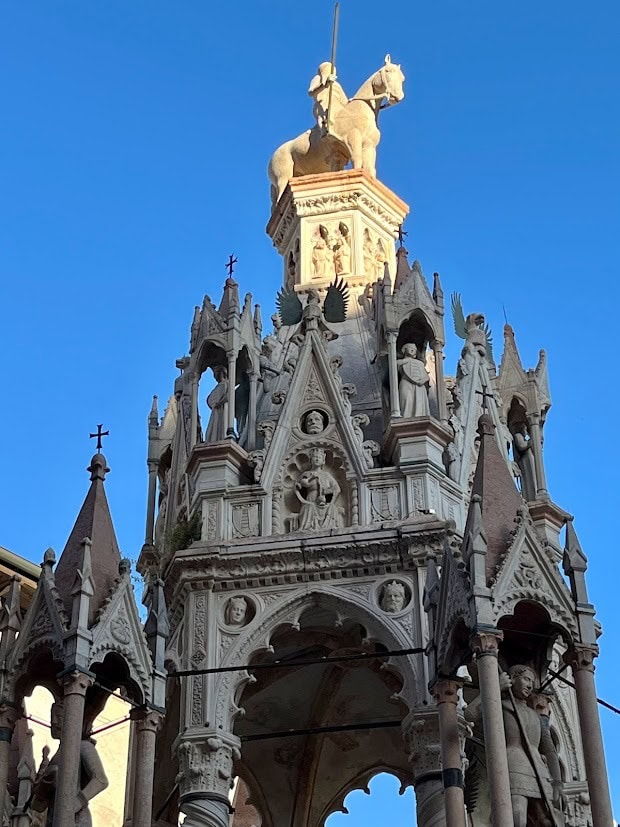
Dinner and a View
After an exhilarating and exhausting day of sightseeing, a relaxing dinner in a beautiful location is always welcome. With this in mind, we dined one evening at the Re Teodorico Bar and Restaurant near Piazzale Castel San Pietro on San Pietro Hill overlooking the Adige River.
The hill has been inhabited since the beginning of Roman times, and the restaurant has been there for sixty years. The views from this spot are spectacular, and the food outstanding.
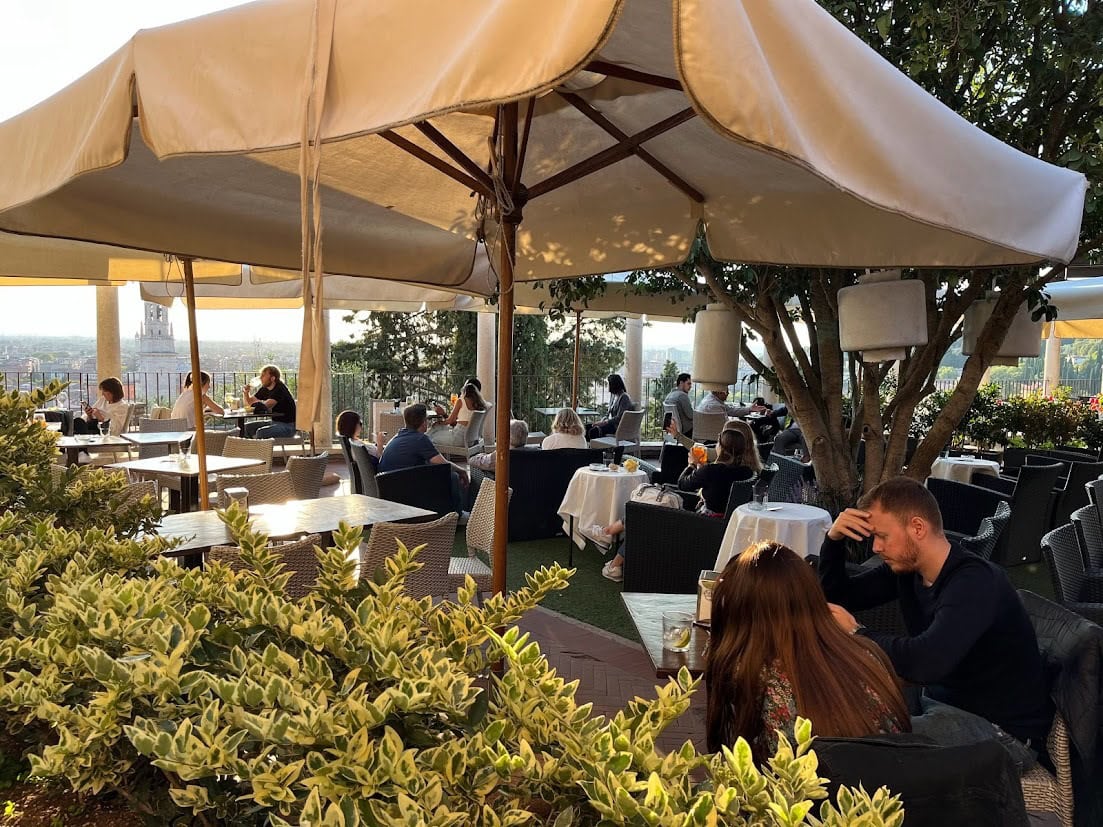
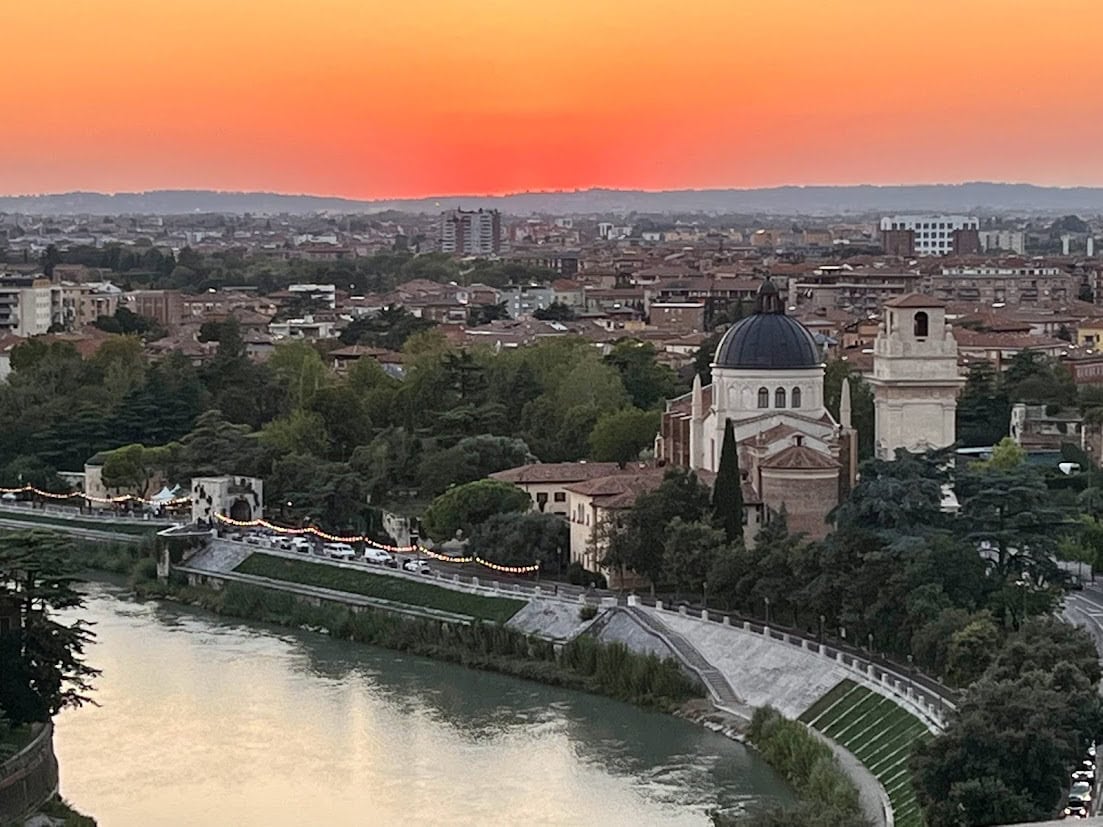
Verona’s Castelvecchio
The della Scala family not only adorned Verona with magnificent tombs but also a magnificent castle.
The Castelvecchio is a massive fortress built next to the Adige River from 1354 to 1355 during the reign of Cangrande I.
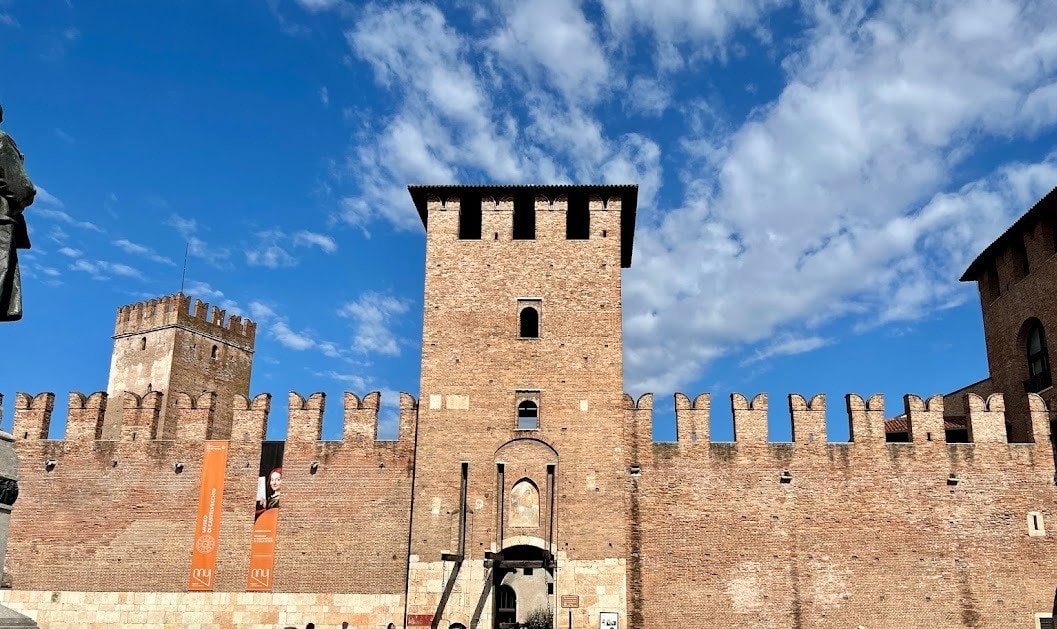
The fortified structure even spans the river, providing the castle inhabitants with a protected escape. Today, everyone can “escape” across this carefully reconstructed and gracefully arched Ponte di Castel Vecchio, a pedestrian bridge.
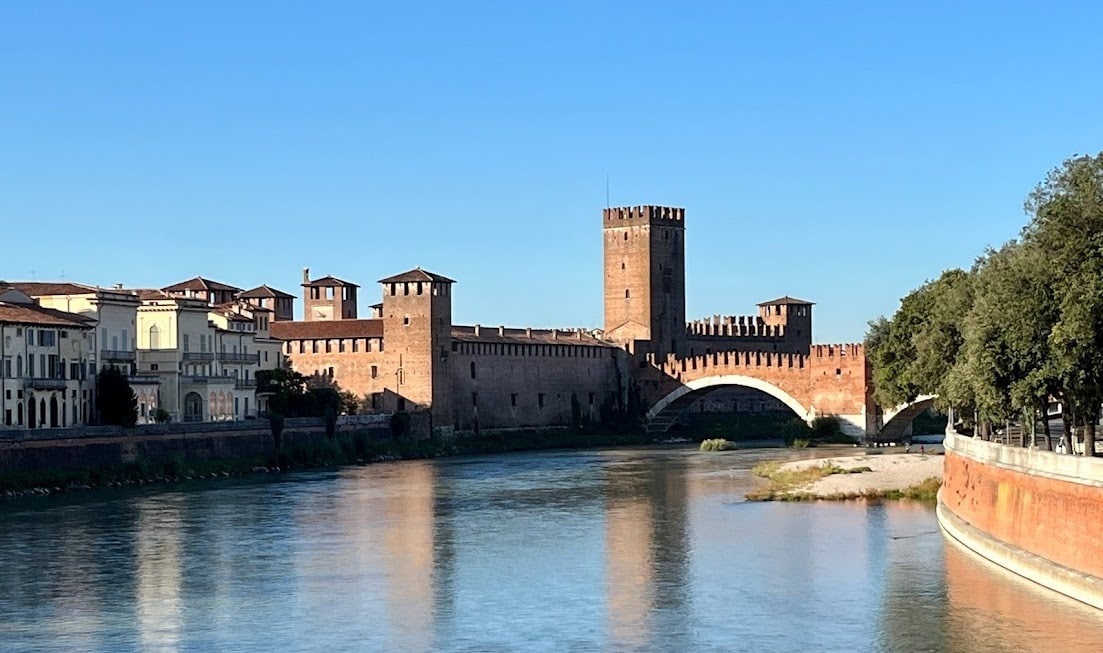
Civico Museo d’Arte
The castle interior has been restored and transformed into bright exhibit spaces that include the collections of the Civico Museo d’Arte.
Paintings
The collection features sculptures and decorative arts in addition to paintings by Bellini, Rubens, Montagna, Guardi, Tiepolo, Tintoretto, Pisano, and artists of the fifteenth- and sixteenth-century Veronese school.
The detail below is from a painting called Madonna dell’ombrello (Madonna of the Umbrella), created by Girolamo dai Libri (Girolamo of books). Besides being a painter of large-scale works, he was also a manuscript illuminator, which explains his name and his ability to paint such beautiful, meticulous details.
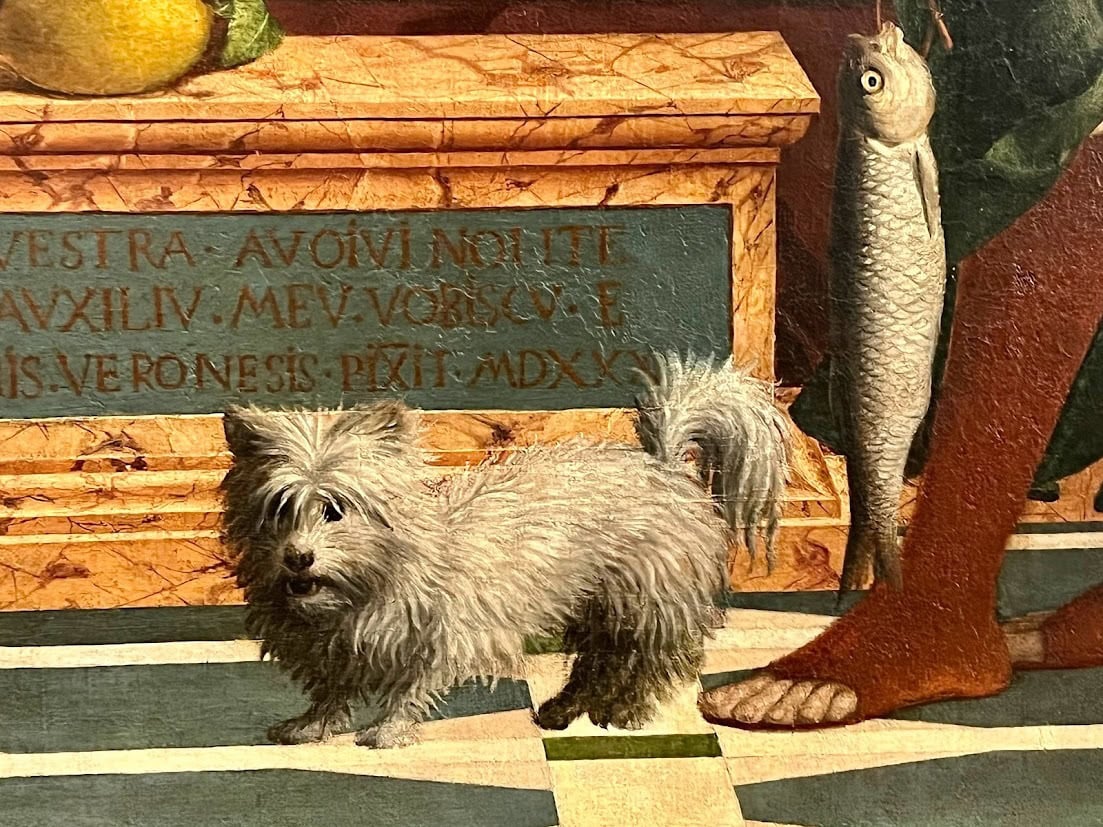
You can see the complete painting below. Although Girolamo is not known as one of the Renaissance greats, I find this piece captivating.
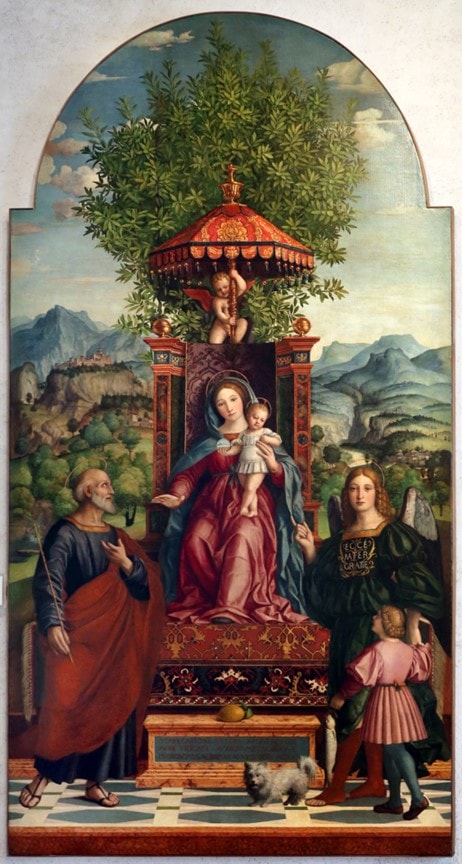
Statues
Outside on the castle grounds stands the original equestrian sculpture of Cangrande I—a Gothic art masterpiece.
Although Cangrande was christened Can Francesco, his nickname—big dog in Italian—probably came from his physical and mental prowess. This nickname also explains the large dog-headed helmet with eagle wings that leans back on his shoulders in the sculpture.
But besides the elaborate helmet, the most striking thing about this artwork is Cangrande’s expression. Instead of looking serious or fierce, he appears to be resting between conflicts with a self-satisfied grin.
History remembers Cangrande as incredibly strong and brave in battle, but he was also known for his friendly and kind disposition. This sculpture, then, celebrates both the great warrior and the affable man.
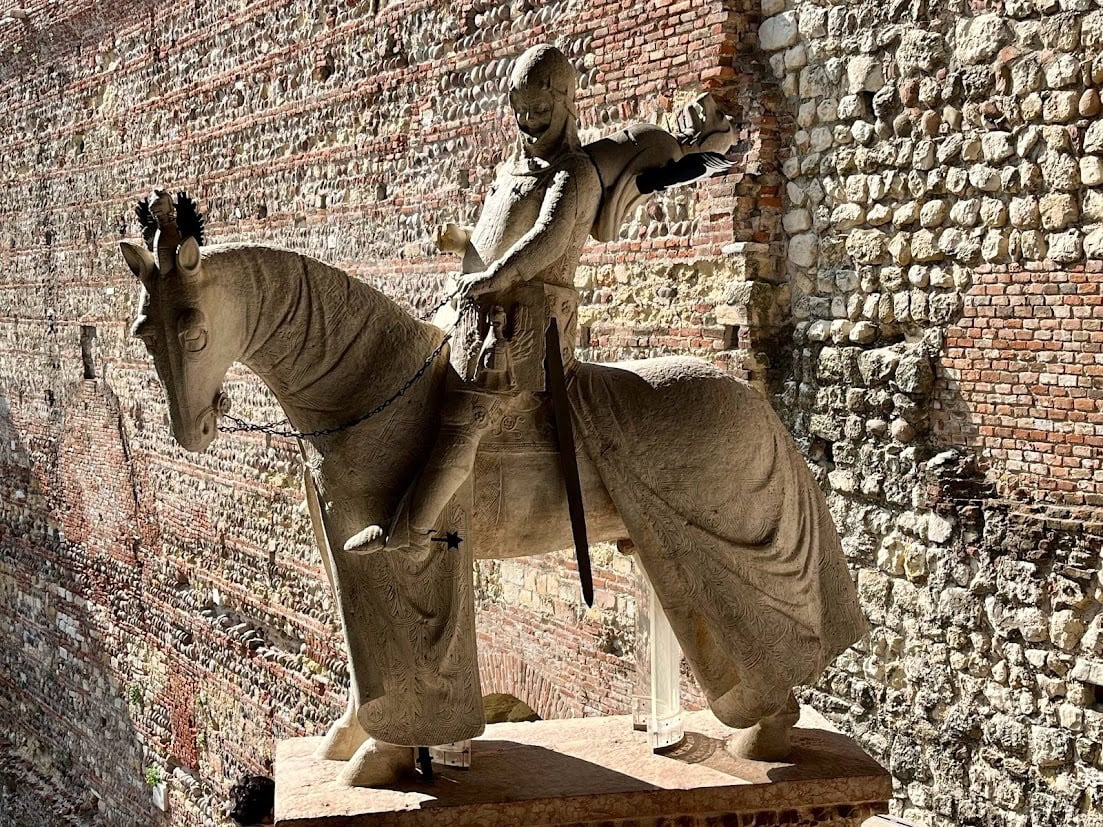
In a corner tower of the castle’s raised walkways, you can also see the original equestrian monument of Mastino II. He came into power after Cangrande I died. Like his uncle, he’s shown in full armor. But instead of being relaxed, he’s prepared for a fight, his face hidden behind a helmet in the form of a winged mastiff. As with Cangrande I, the helmet references his name. Mastino means mastiff in Italian.
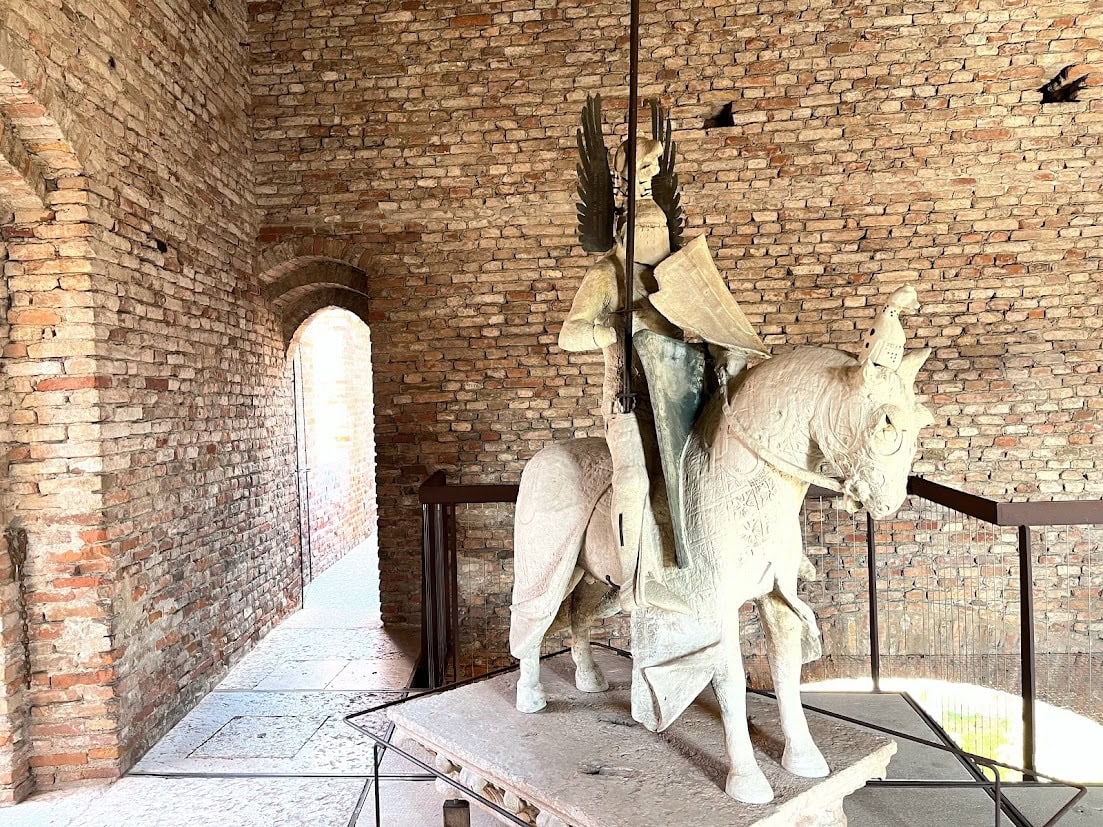
The Basilica of San Zeno, Verona
Leaving the Castelvecchio, we walked west along the Adige River until we came to a large eleventh- twelfth-century basilica dedicated to San Zeno, the fourth-century Veronese Bishop and Patron Saint of Verona.
But let me digress here for a moment. Although I wrote at the beginning of this post that my focus for this trip was not Romeo and Juliet, tradition says this church is where they married. So, as it turns out, we did see one of Romeo and Juliet’s haunts (although not the famous balcony, and quite unintentionally).
The church of San Zeno (pictured in the center below) is flanked by its elegant campanile on the right and the Benedictine abbey on the left with its classic medieval defensive tower. The three make a striking architectural ensemble.
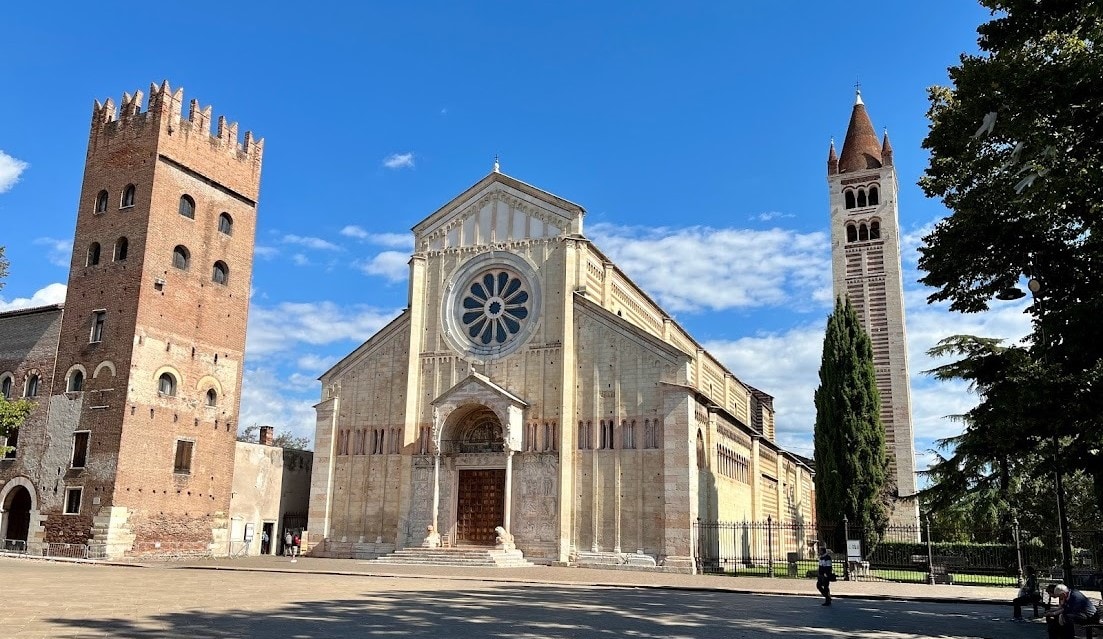
We accessed the church through a side entrance. The front portal stays shut to protect the massive interior bronze doors with their marvelously expressive Romanesque reliefs dating from the eleventh to the thirteenth centuries. Here is a detail from the bronze door.
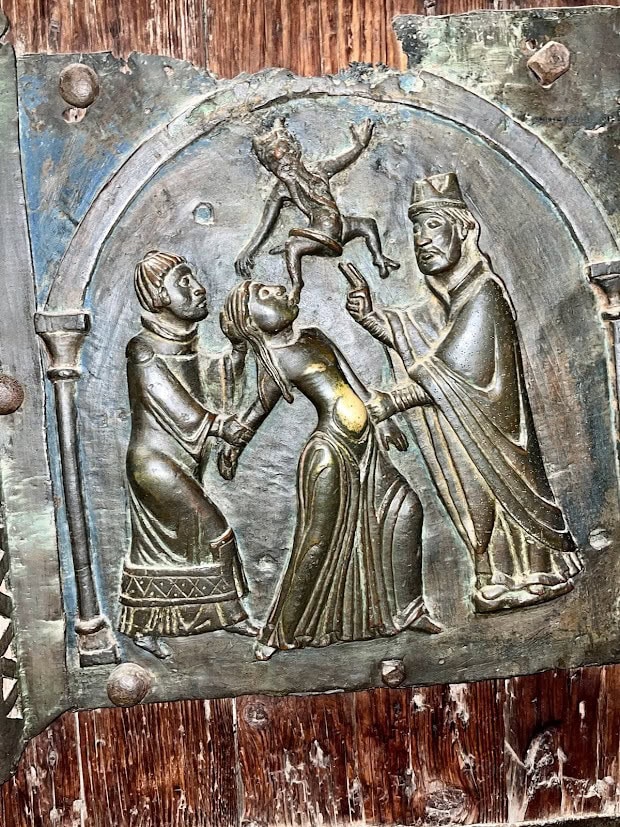
Along with its masterful bronze portals, the church interior includes an exquisite one-of-a-kind, fourteenth-century wooden roof and walls covered with frescoes from the thirteenth to the fifteenth centuries. Some of these frescoes have peeled away over time to reveal the earlier paintings underneath, making marvelously surreal images.
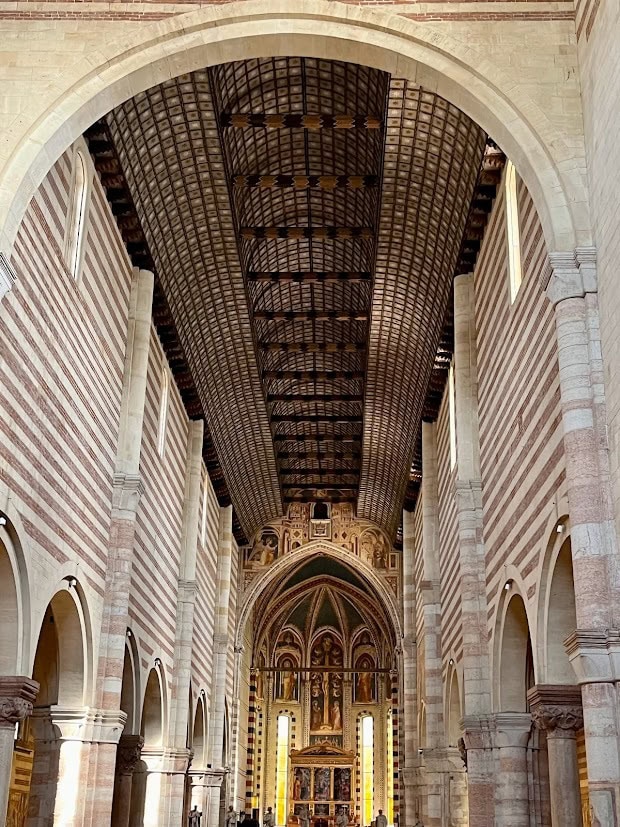
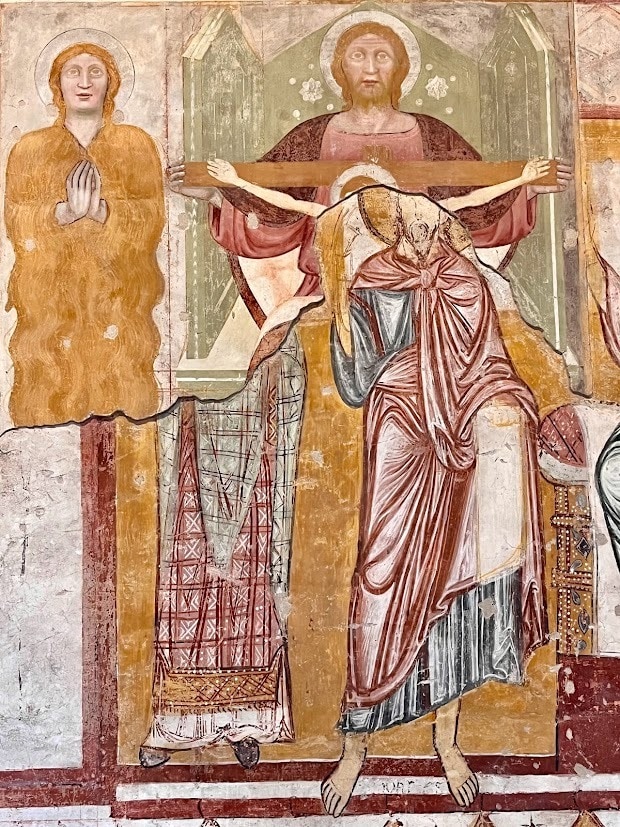
The pièce de résistance in this church is the elaborate fifteenth-century painting—Madonna with Saints—behind the high altar. Andrea Mantegna—one of the great artists of the Italian Renaissance—created this exquisitely detailed masterwork.

Staying in Verona
As I mentioned in the beginning, we did a house exchange in Verona, but our friends (seasoned travelers) recently stayed in Hotel Torcolo, located a few steps from the arena in the heart of the old town. They loved its location, antique charm, and a restaurant (pictured below) with great food and wine.
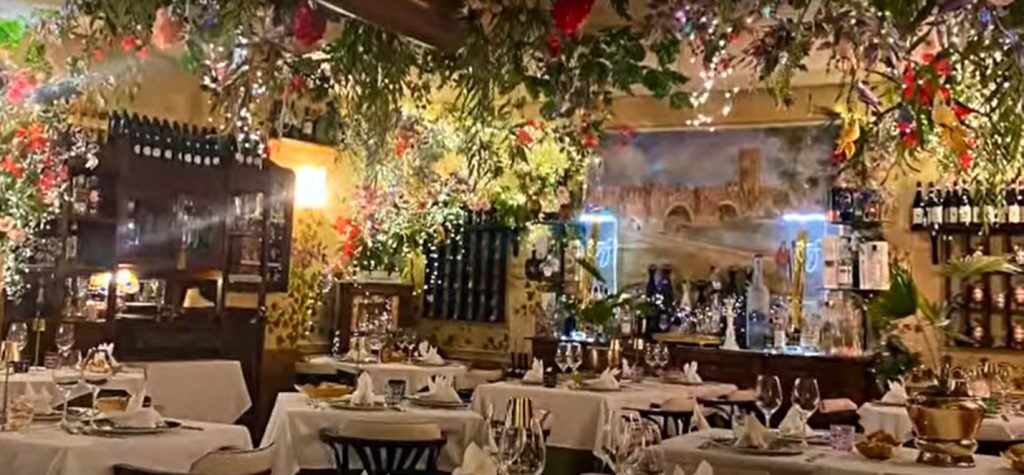
Day Trip to Lake Garda
During a week stay in Verona, consider taking a day trip to beautiful Lake Garda. The train from Verona Porta Nuova train station to Desenanzo del Garda/Sirmione takes just 20 minutes. Check out the Artsy Traveler post on Sirmione.
Here is a day trip with GetYourGuide:
Conclusion
So, there’s my take on Verona in a nutshell. It’s a marvelously rich town on so many levels—the architecture, the art, the history, the landscape, the food, and, well, yes, the Romeo and Juliet lore!
Have you visited Verona? Share your recommendations for other artsy travelers in the Comments below.
Here are some more posts about destinations in northern Italy:
